I’ve been keeping shrimp for years, and kept a huge variety of plants in these tanks. And if there’s one thing I’ve learned, the more foliage to graze on and places to hide makes them feel safe. And when shrimp feel safe, that’s when all their odd-ball like behaviors start showing.
To help you decide which plants to keep in your shrimp tank, I recently purchased and replanted 15 varieties of aquarium plants, and added them to my tanks to give you an understanding of what to expect for each plant.
Reading this guide will help you learn the pros and cons of different plants and how each one will help support a healthy environment for your shrimp.
Best Plants For Shrimp Tanks Overview
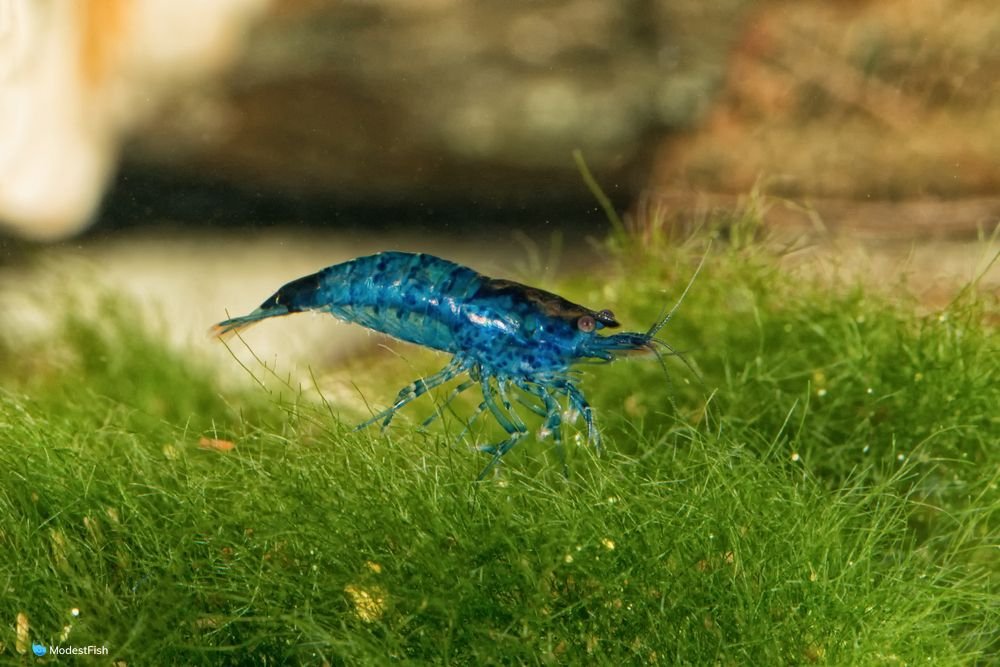
- Java moss (Taxiphyllum barbieri) 9.0: Grows as a messy tangle of lanky fronds that shrimp love to explore.
- Guppy grass (Najas guadalupensis) 8.9: Quickly forms a dense jungle of stems that is a perfect habitat for shrimps to breed in.
- Anacharis (Elodea sp.) 8.6: Shrimp love to graze along the surface of this fast growing plant, but it doesn’t provide much cover.
- Hornwort (Ceratophyllum demersum) 8.5: A fast growing background plant whose bushy growth provides both feeding ground and cover.
- Anubias congensis 8.5: A taller species that tends to accumulate algae that shrimp will gladly feed on.
- Pearl weed (Hemianthus micranthemoides) 8.2: The easiest carpeting plant in the hobby, the perfect thing for shrimp to crawl around in.
- Crypt wendtii (Cryptocoryne wendtii) 8.0: This tiny crypt makes an excellent foreground plant that shrimp will love to hide in.
- Java fern (Leptochilus pteropus) 7.8: Shrimp love to graze on algae that grows on Java fern leaves and roots.
- Water sprite (Ceratopteris thalictroides) 7.8: Grows quickly, eating up nitrates, and providing lots of surface area for shrimp to graze on.
- Water wisteria (Hygrophila difformis) 7.8: Similar to water sprite, but a little less delicate; it also helps eat up nitrates, making for a healthier environment for your shrimp.
- Anubias barteri 7.8: Easy to care for and has beautiful broad leaves that shrimp can graze along.
- Anubias nana 7.8: A dwarf species that can provide good cover for shrimp in the foreground of a tank.
- African Water Fern (Bolbitis heudelotii) 7.7: This plant is slow to grow, but provides an excellent feeding ground for shrimp in large tanks.
- Crypt lutea (Cryptocoryne lutea) 7.4: This large crypt species makes an excellent centerpiece plant with broad leaves shrimp can graze along.
- Moss balls (Aegagropila linnaei) 6.9: These little green oddballs require almost no care and shrimp love to graze on them.
How I Tested & Ranked The Plants
To find the best plants for shrimp tanks, I rated 15 different species on 10 different data points (see below). The purpose of this is to help you see the pros and cons of different plants. They’ll all work in a shrimp tank, but some plants bring more to the table than others.
However, because this article is focusing on plants which help create the best habitat for shrimp, the score for compatibility was weighted at 55% of the total score, making it the most important factor. Everything else was weighted at 5% (to add up the remaining 45%).
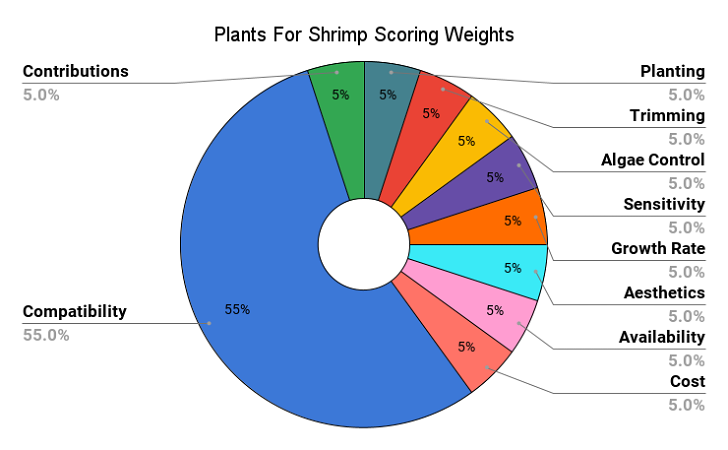
The plants were given a score of 1-10 for the following criteria:
- Compatibility (55% of total score) – how much do shrimp like this plant and does it create a happy habitat for shrimp?
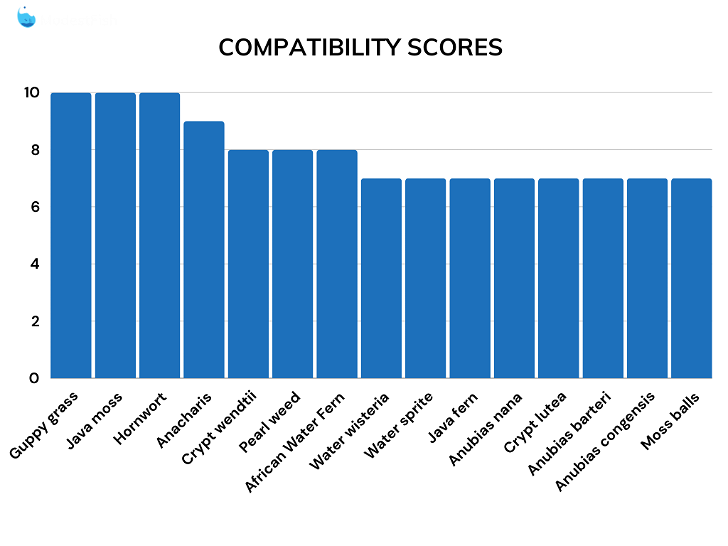
- Planting (5% of total score) – how hard is it to place the plant in the tank and get it to stay put?
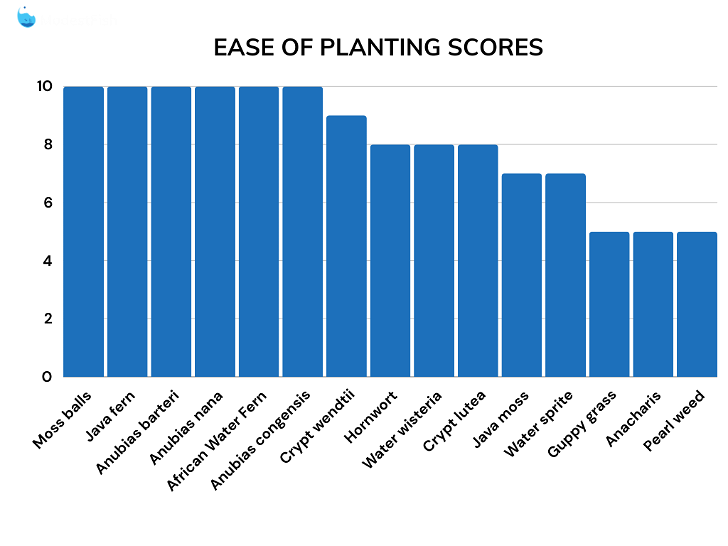
- Trimming (5% of total score) – how frequently does the plant need to be trimmed?
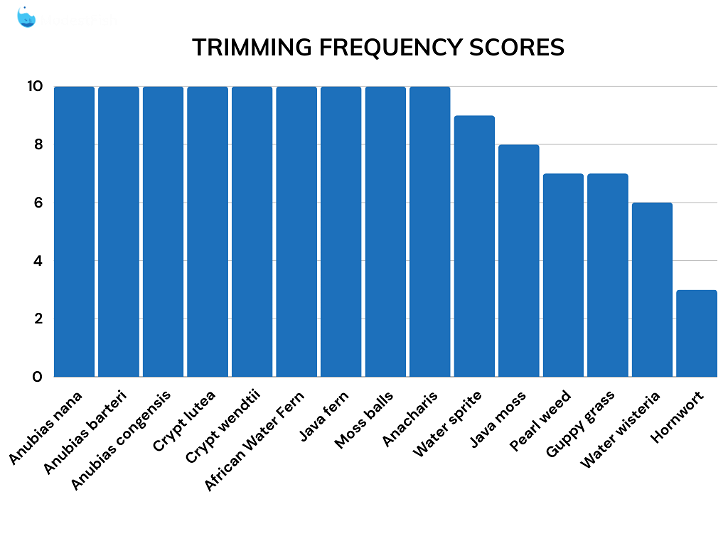
- Algae control (5% of total score) – how difficult is it to remove algae from the plant?
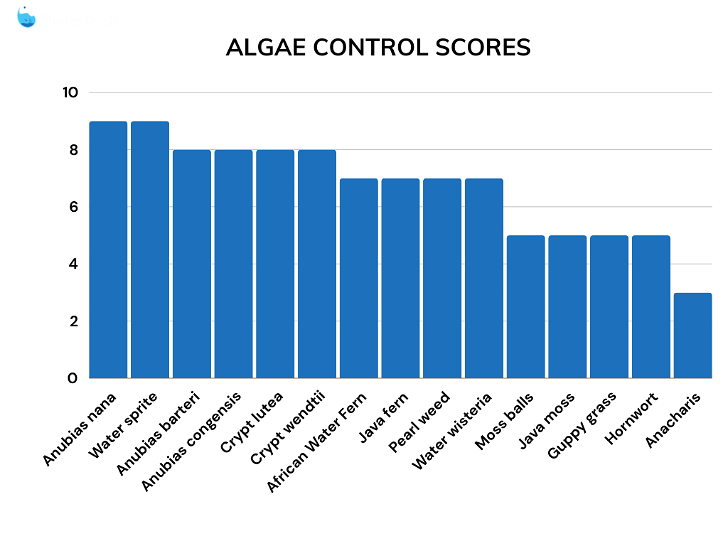
- Sensitivity (5% of total score) – do changes in water parameters cause the plant to melt back and lose its leaves?
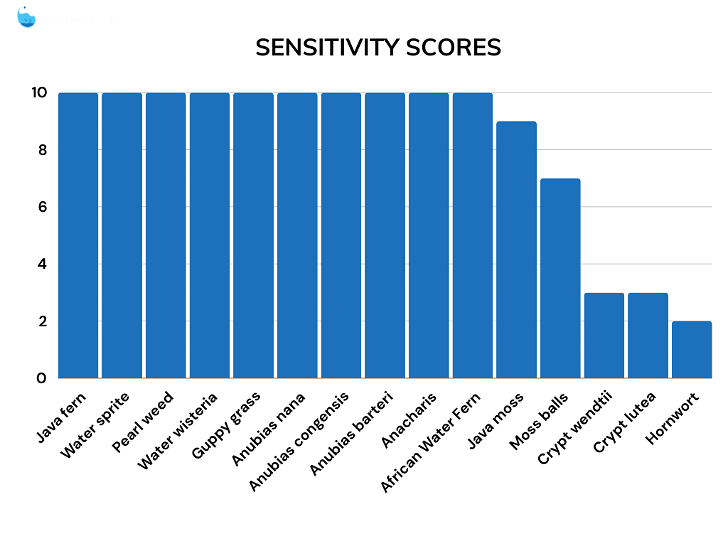
- Hardiness (5% of total score) – is the plant tolerant of varying conditions and/or benign neglect over time?
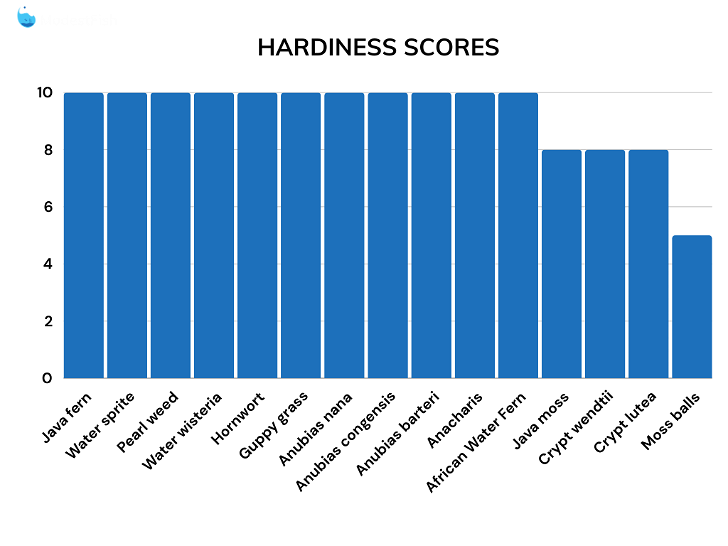
- Aesthetics (5% of total score) – how attractive is the plant to look at?

- Availability (5% of total score) – how easy or difficult is it to find the plant in stores and online?

- Cost (5% of total score) – how much does the plant cost versus how much of it you get when you purchase it?
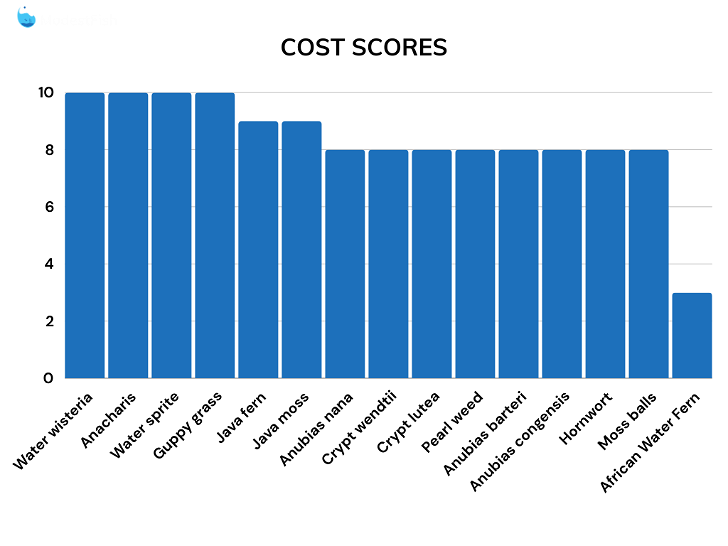
- Contributions (5% of total score) – how much nitrate and other excess nutrients does the plant eat up?

Best Plants For Shrimp Tanks Reviewed
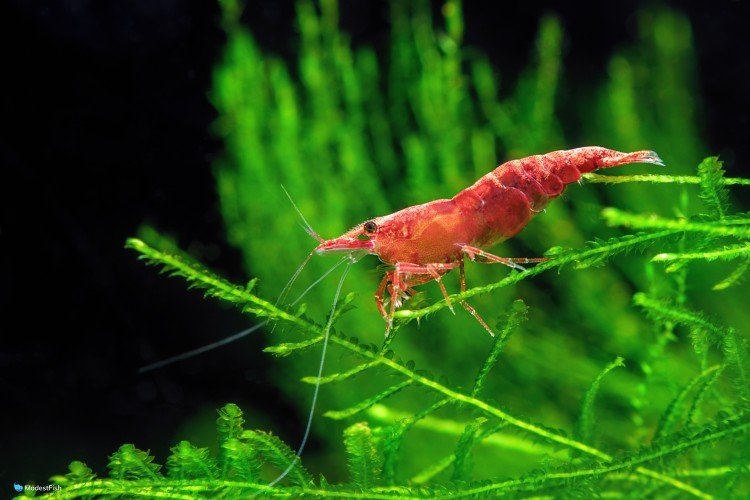
1. Java Moss (Taxiphyllum barbieri)
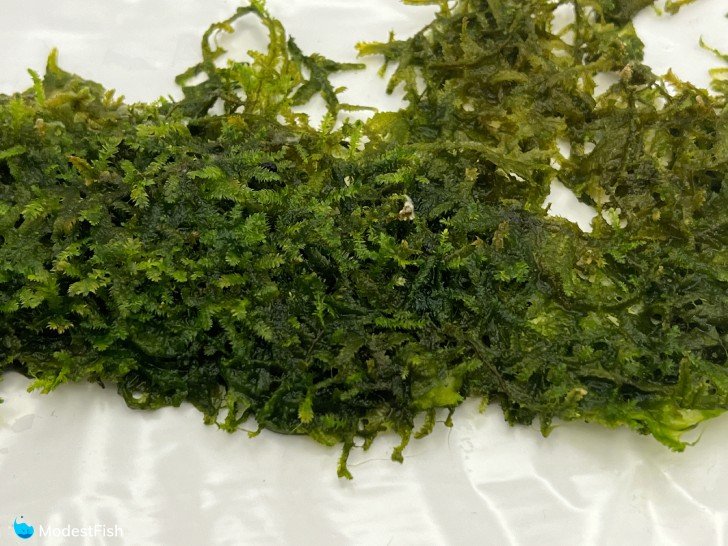
Java moss is one of the easiest aquarium mosses to grow and can tolerate very low lighting.
Growing into what can only be described as a tangle of messy green hair, it provides a perfect environment for shrimp to hang out in and feel safe.
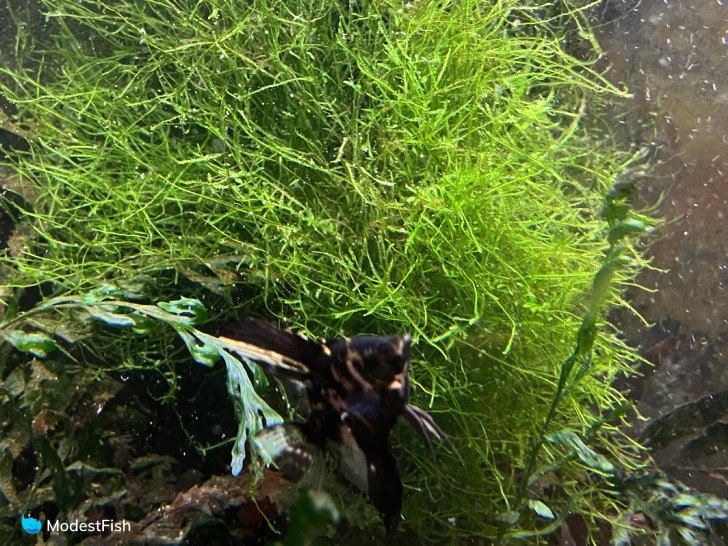
They can hide among the fronds and feed off algae and infusoria that grow on and around the moss.
Granted, it’s not as pretty as Christmas or flame moss, but it’s much more tolerant and easier to care for. Especially if you’re a beginner.
It’s easy to plant. I usually just super glue some small chunks to rocks and simply place it in the tank. As it grows, it will start to adhere to the surface on its own.
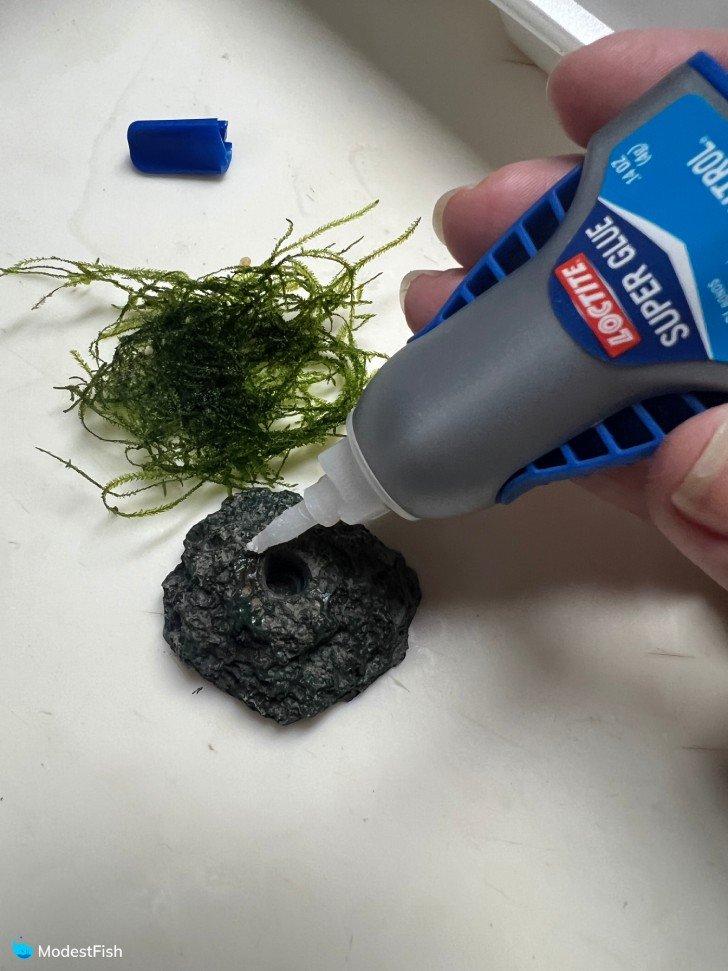
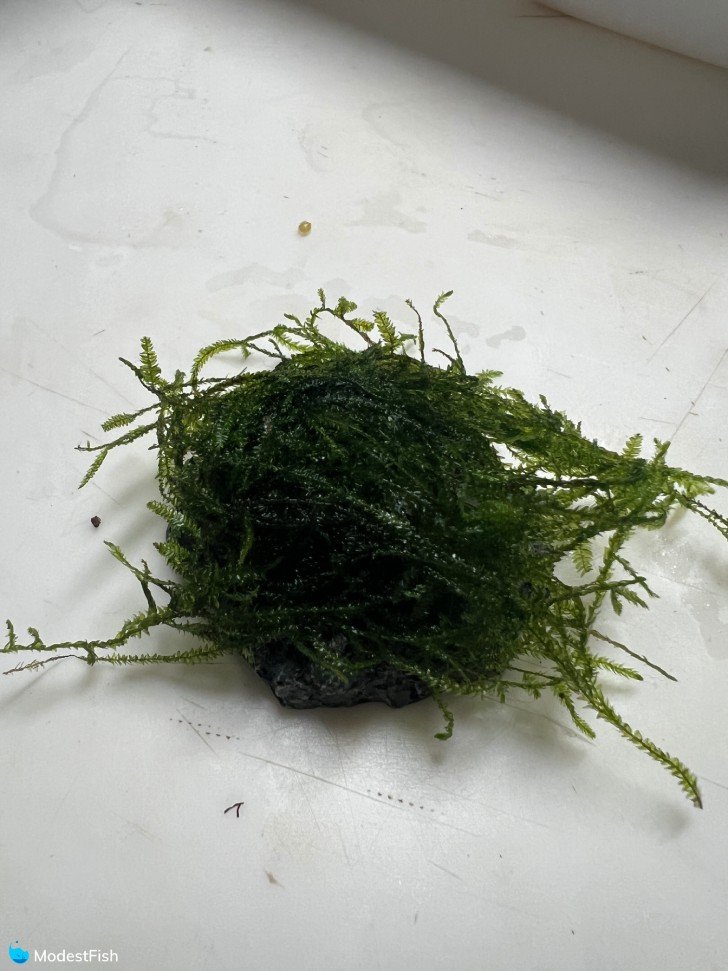
You can shape it up by giving it a quick trim with scissors if it starts to get too overgrown for you.
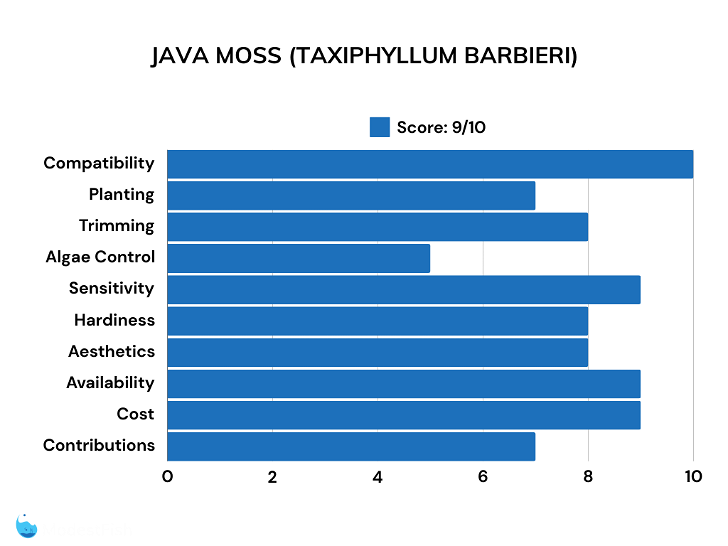
Pros:
- Grows quickly
- Great for fry and shrimplets
- Easy to plant and maintain
Cons:
- Can look a bit messy
Verdict – Java moss grows as a messy tangle of lanky fronds that shrimp love to explore.

Last update on 2024-04-18 / Commissions Earned / Images from Amazon Product Advertising API
2. Guppy Grass (Najas guadalupensis)
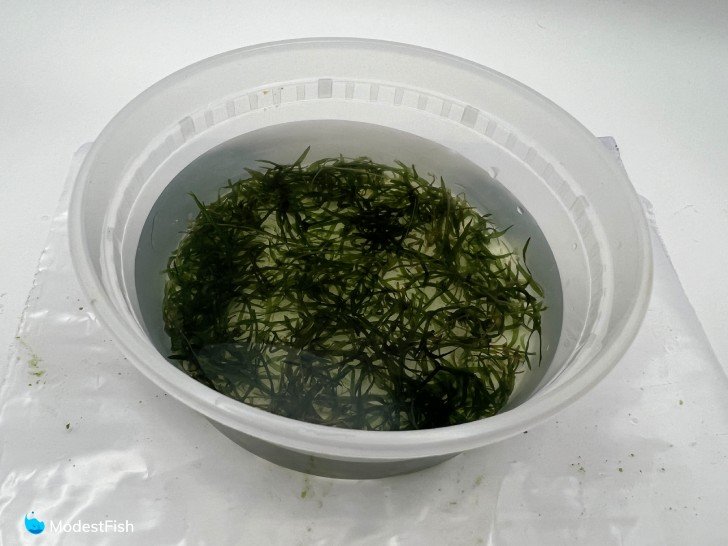
Guppy grass is an extremely fast growing plant, and in my experience, it quickly becomes a mass of bushy, tangled grass. Making it perfect for shrimp and breeding shrimp.
The dense foliage houses infusoria, which provides a food source for shrimp to graze on.
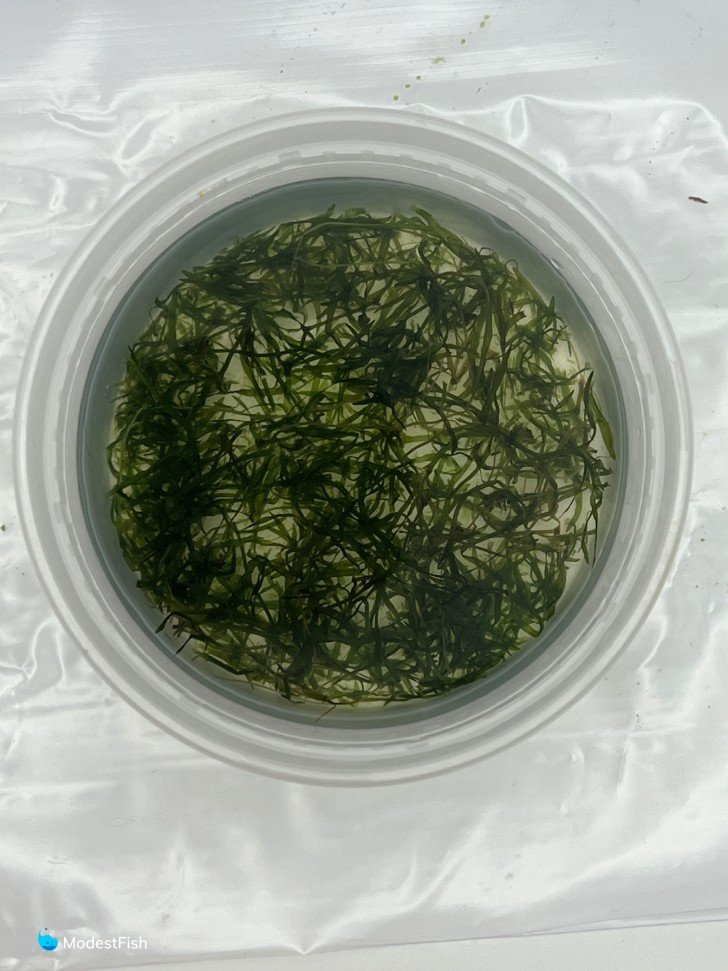
Because of the speed of growth, guppy grass can have a major positive impact on the water parameters in your shrimp tank. It does an excellent job of consuming excess nitrates directly from the water column.
However, fast growth does mean it can require frequent trimming. Or it may take over your tank. I have found trimming the tops (dispose of in trash) is enough to keep it under control.
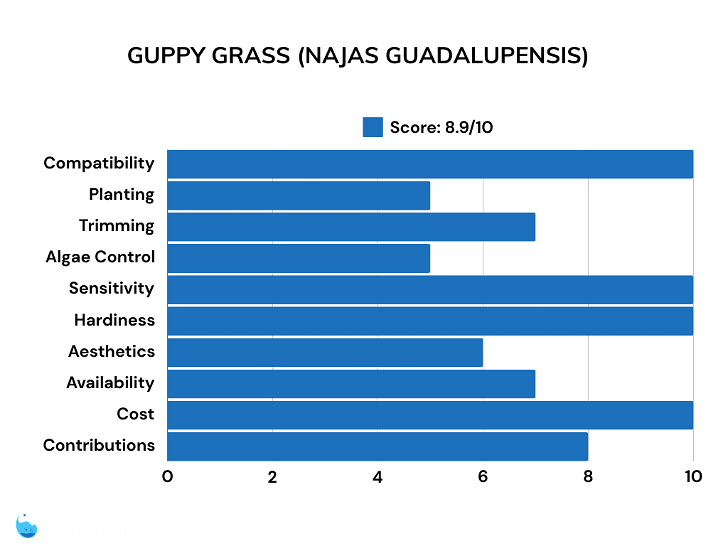
Pros:
- Great cover for shrimp and shrimplets
- Reduced nitrate in the water column
Cons:
- Requires frequent trimming
Verdict – Guppy grass quickly forms a dense jungle of stems that is a perfect habitat for shrimps to breed in.
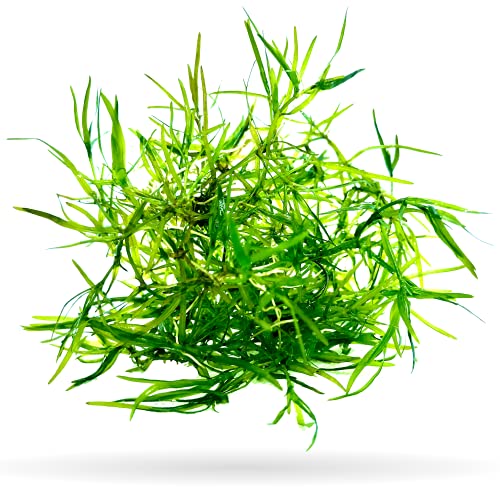
Last update on 2024-04-18 / Commissions Earned / Images from Amazon Product Advertising API
3. Anacharis (Elodea sp.)
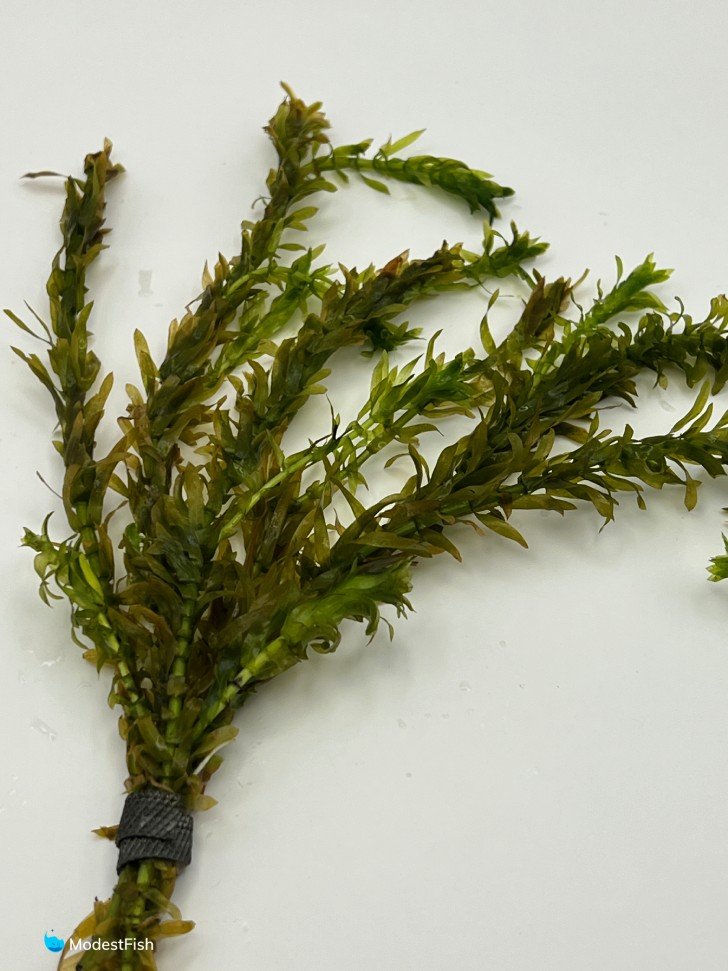
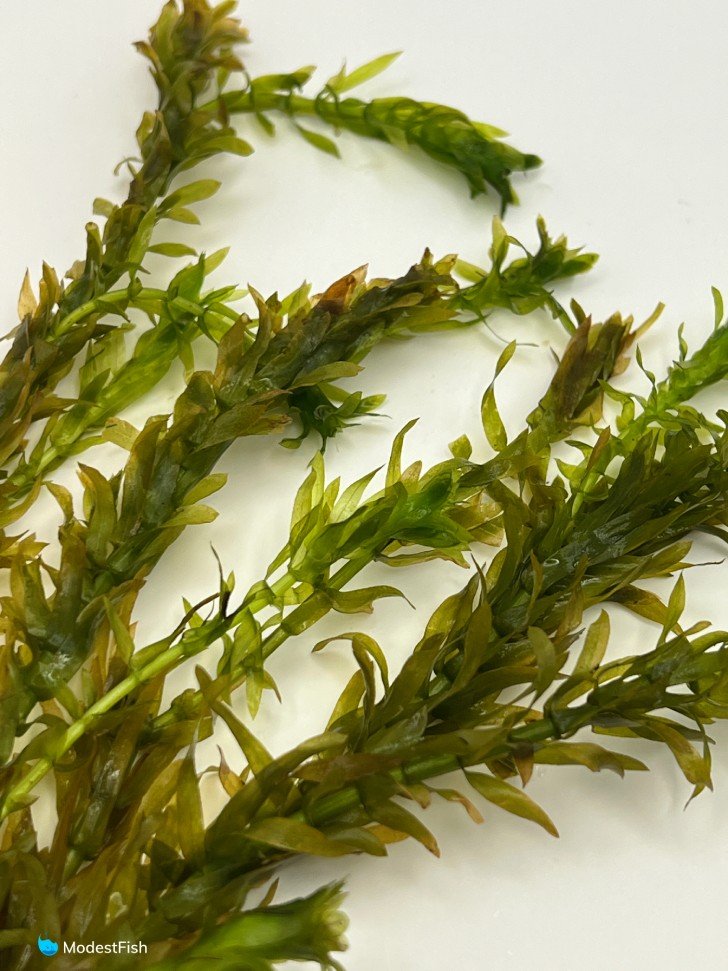
Anacharis can be an excellent plant for shrimp if you don’t mind a reasonable amount of maintenance.
It tends to grow very quickly in my tanks, and my shrimp love to graze along the surface.
And all that fast growth means the plant eats up a lot of nitrate out of the water column. Anacharis is a stem plant, meaning that it feeds through its leaves, absorbing nutrients directly from the water column, instead of through its roots.
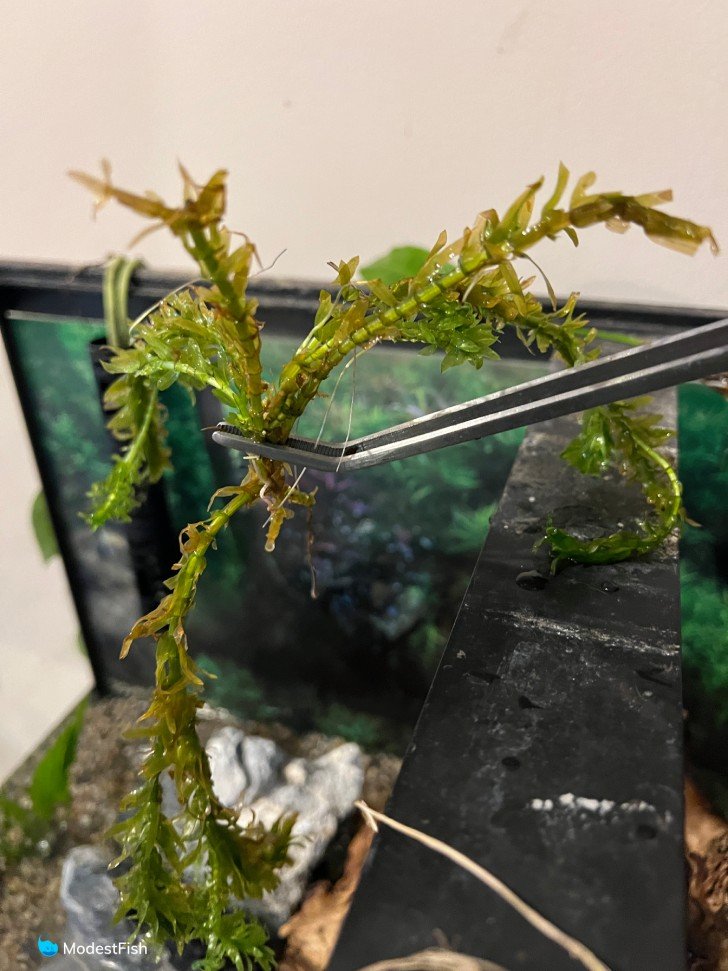
But, the fast growth also means that you’ll frequently have to trim it. The bottom of the plant can get really raggedy and beat up looking, so it’s often necessary to pull up the whole plant, cut off the bottom portion and then replant the tops.
It might not seem like a big deal at first, but it can get tiresome over time.
It can be difficult to clean algae off yourself, but this is seen as a bonus for shrimp as they’ll like to spend their days eating it.
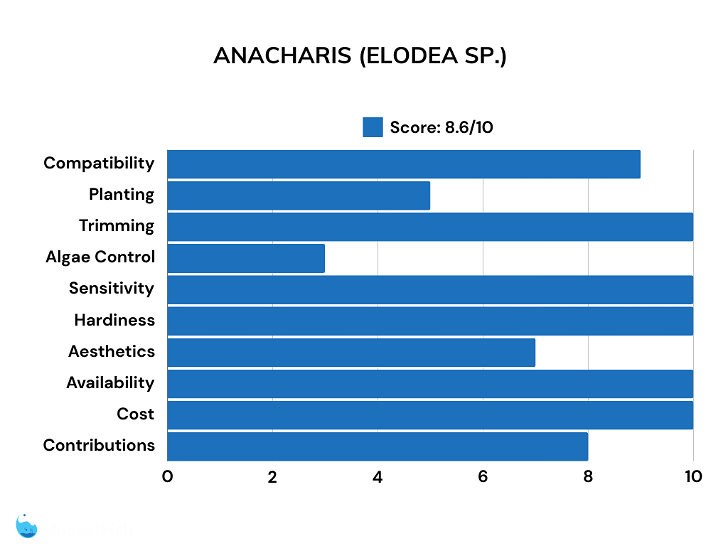
Pros:
- Fast growing plant that can really lower nitrates
- Will quickly grow to the top of the tank
- Shrimp love to graze on the leaves
Cons:
- Requires frequent trimming and replanting
- Doesn’t provide much cover for shrimp
Verdict – Shrimp love to graze along the surface of this fast growing plant, but it doesn’t provide much cover.

Last update on 2024-04-18 / Commissions Earned / Images from Amazon Product Advertising API
4. Hornwort (Ceratophyllum demersum)

I’m a big fan of hornwort (also known as coon tail). I love how it’s bright its green pine needles are and they provide excellent cover for shrimp and shrimplets.
Hornwort is a fast growing stem plant that’ll draw nutrients from the water column. Whenever I have hornwort in my tanks, I always notice their positive effect on nitrate level.
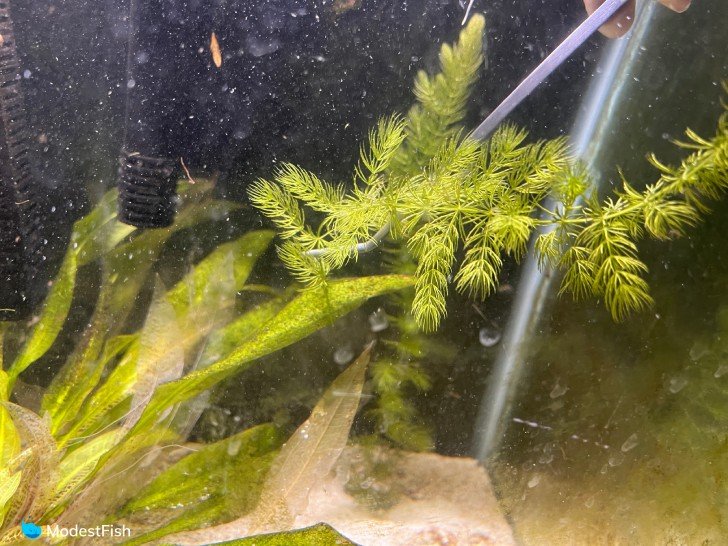
The only issue is it can be a bit troublesome when getting established. Sometimes it’ll drop its needles and melt back when first introduced. But it’s always recovered in my tanks.
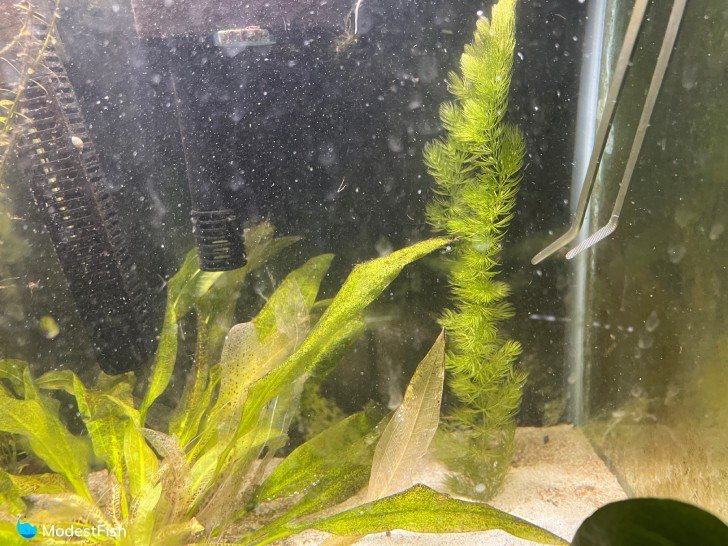
This process can make a bit of a mess in your tank. So if you want to avoid this, you can quarantine the plant in a bucket with a bubbler or bare bottom tank. Use old water from your tank so it can get used to the parameters. Once it bounces back you can plant it in your tank.
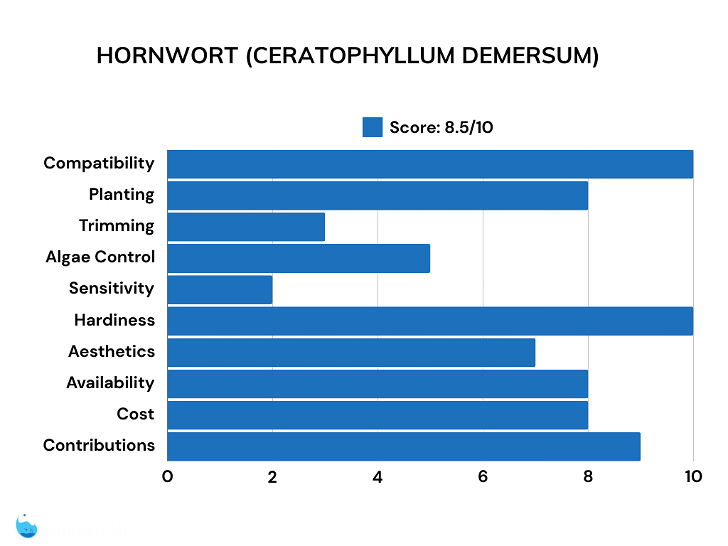
Pros:
- Fast growing plant that eats up nitrate
- Beautiful distinct shape
- Great cover for shrimp
Cons:
- Very sensitive plant that can be hard to get established
- Very messy if it melts back
Verdict – Hornwort is a fast growing background plant whose bushy growth provides both feeding ground and cover.

Last update on 2024-04-19 / Commissions Earned / Images from Amazon Product Advertising API
5. Anubias congensis
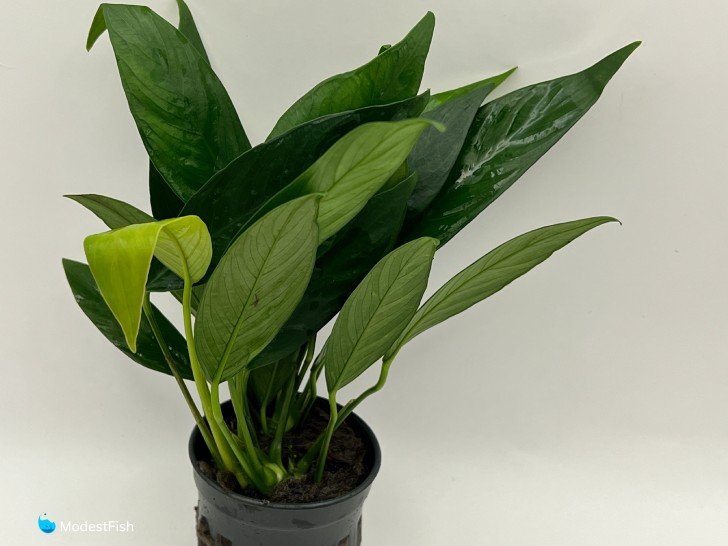
This is the largest species of anubias that I’ve ever owned. I know there are some larger ones out there, but I haven’t kept any and they’re very expensive and hard to find.
Anubias congensis, like other anubias, is slow to get established and grows slowly, but over time, its leaves can grow to be a foot long. And provides plenty of shaded areas to help shrimp feel safe.
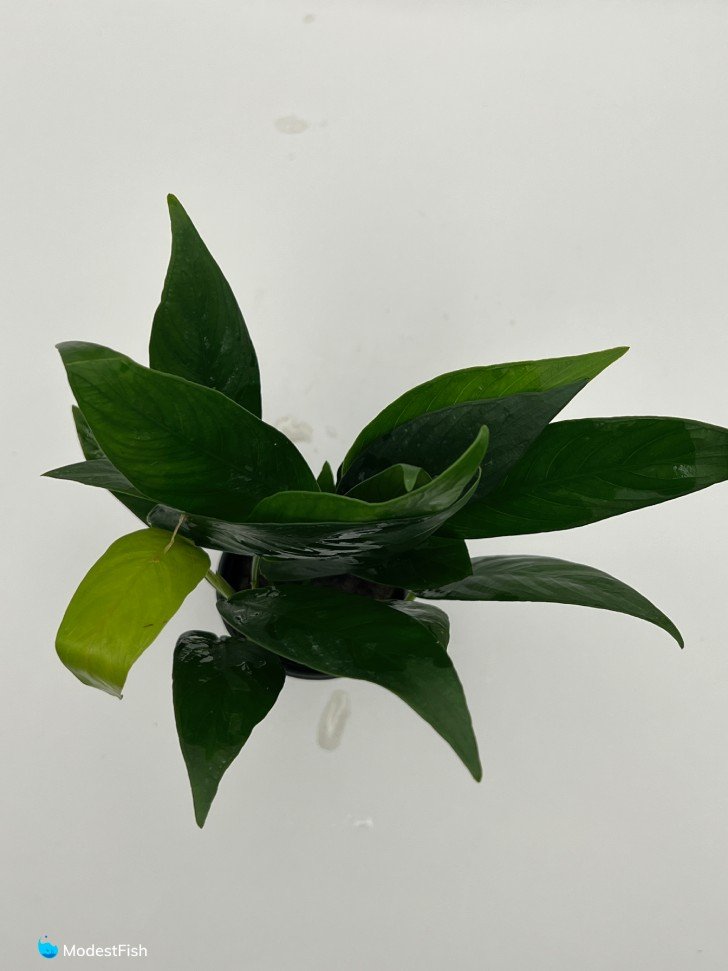
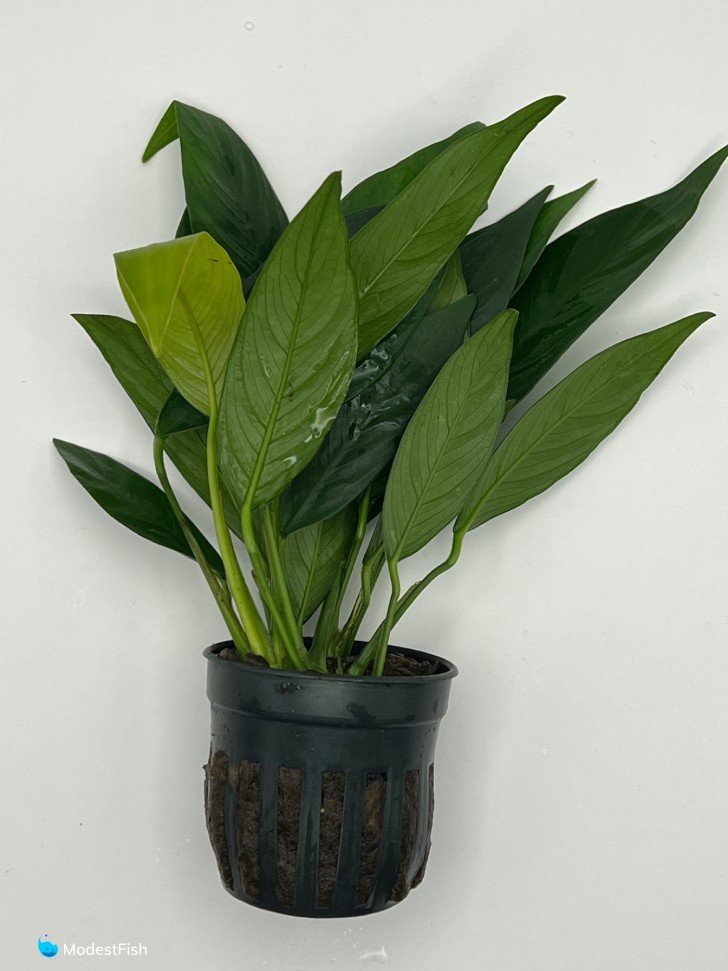
I have one that’s been in my red cherry shrimp tank for several years. It’s gotten so big that I have to trim cuttings off twice a year to keep it from getting completely out of control.
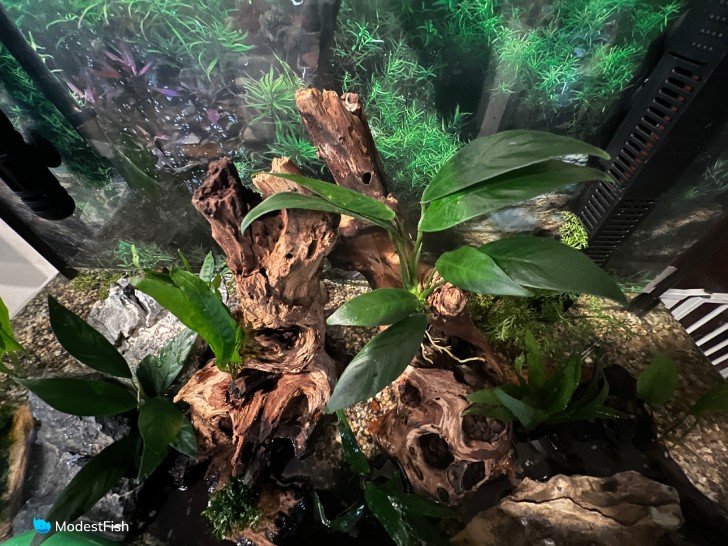
This plant isn’t fussy at all. I’ve always found it to be very tolerant of algae control measures, including rubbing algae off the leaves or spot treating with Seachem Excel and peroxide. But, mostly you can leave this for your shrimp to deal with.
I like to use it as a background plant in small tanks and as a centerpiece in my larger ones. Remember, this is epiphyte, so don’t bury it in substrate.
You can just glue the rhizome to a rock or piece of driftwood. Put it in your shrimp tank and let it get established.
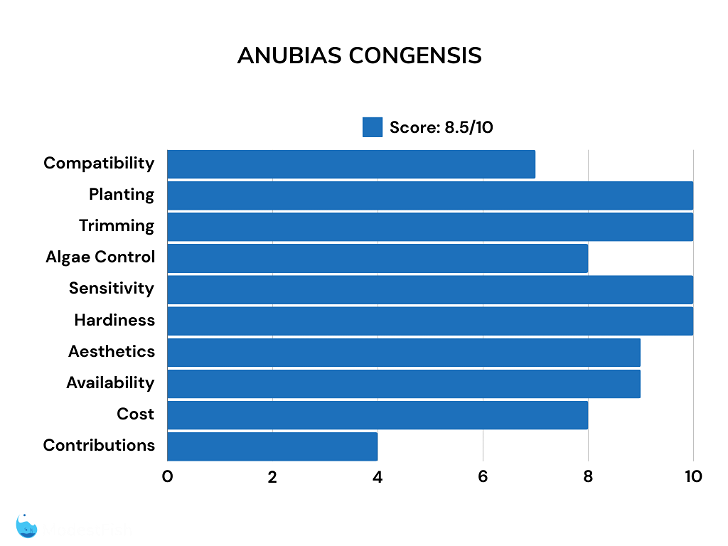
Pros:
- Easy to plant and maintain
- Larger anubias that really stands out
- Beautiful, long, pointed leaves provides shade and cover for shrimp
- Easy to clean off algae
Cons:
- Slow to get established
- Slow growth rate
- Doesn’t eat up much nitrate
Verdict – Anubias congensis is a taller species that tends to accumulate algae that shrimp will gladly feed on.

Last update on 2024-04-18 / Commissions Earned / Images from Amazon Product Advertising API
6. Pearl Weed (Hemianthus micranthemoides)
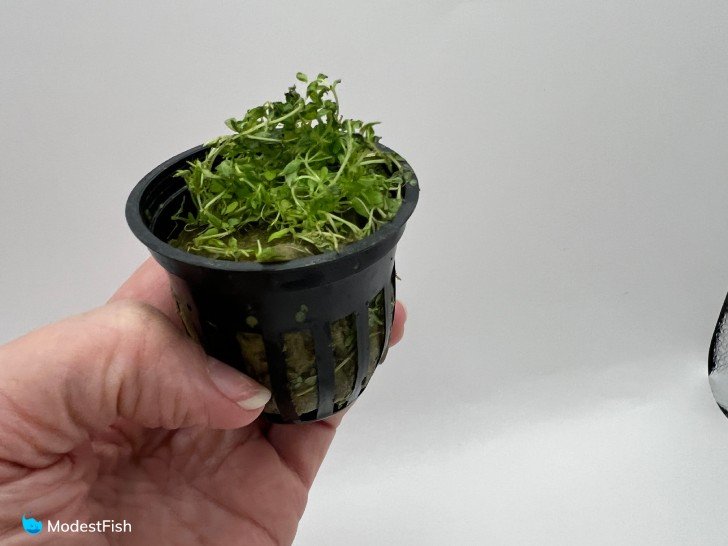
Pearl weed is a really interesting plant. It’s one of the easier carpeting plants in the hobby and provides a great space for shrimp to hide and rummage around in.
Now, I’ve found planting pearl weed to be a bit of a pain. The little stems are very delicate which can easily break when planting into substrate. But, once you’ve got them down in the substrate, the stems grow quickly.
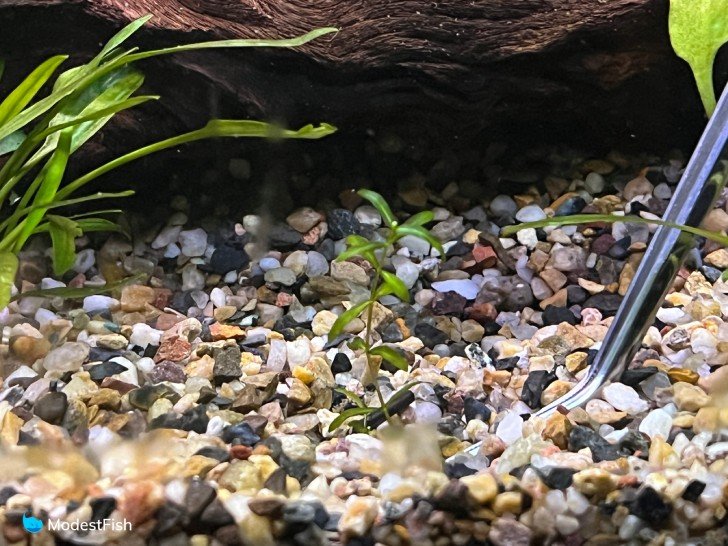
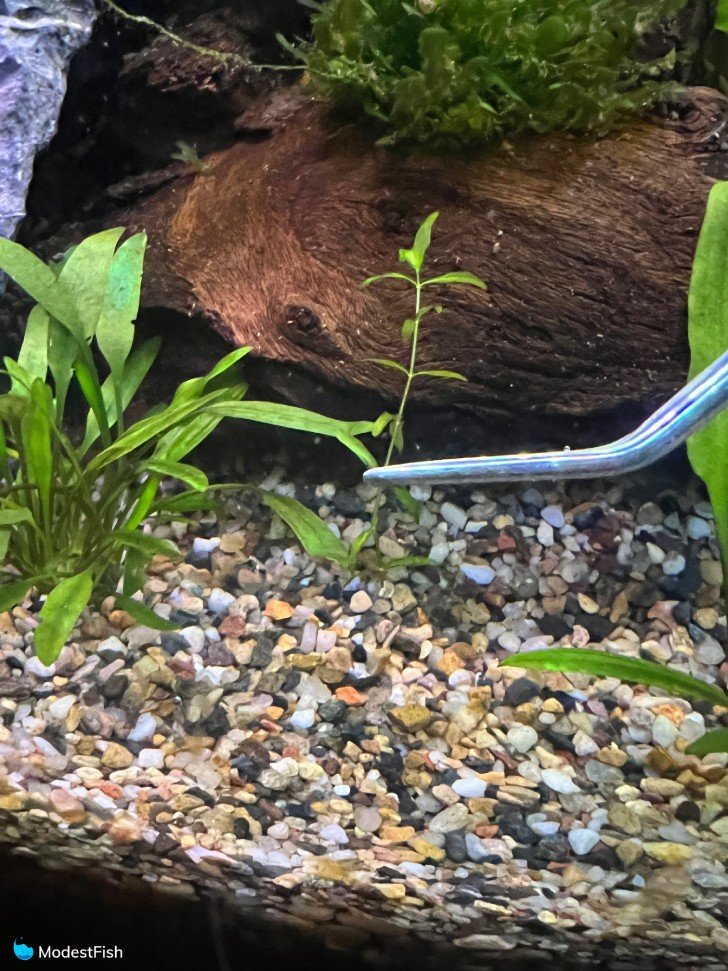
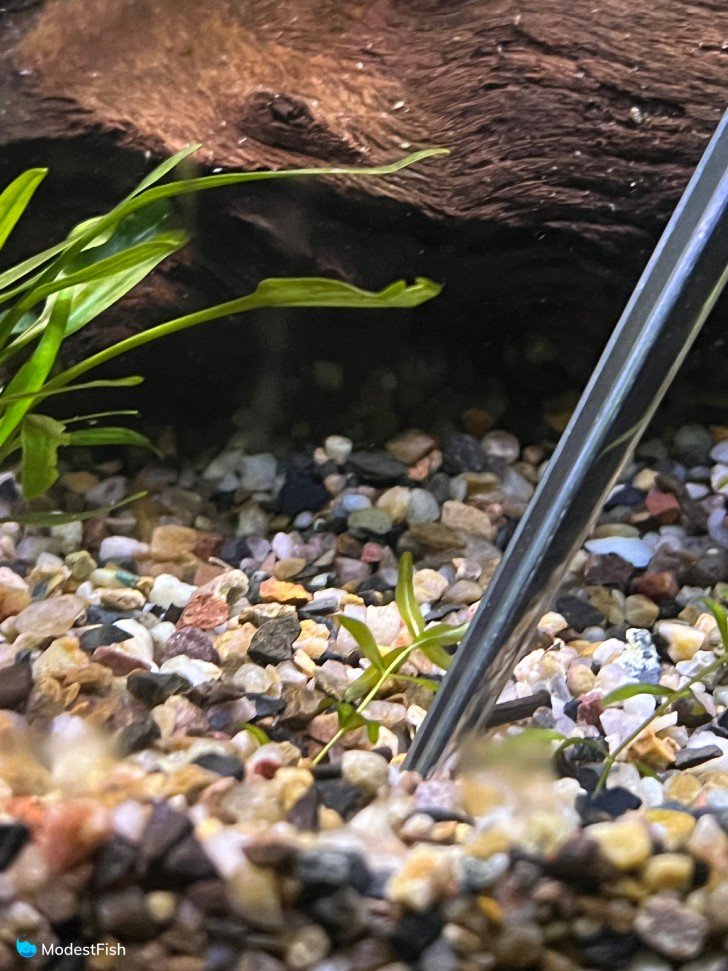
I’ve had good luck growing pearl weed in shrimp tanks with soil, sand and even regular gravel. It can be a little harder to get it to stay down in the gravel at first, but once it roots, it will grow like crazy.
This fast growing plant eats up lots of nitrate directly from the water column.
I have noticed that you need to trim it fairly frequently, especially if you would like it to form a carpet. But any trimmings can be shoved down into the substrate to form new plants and increase the coverage.
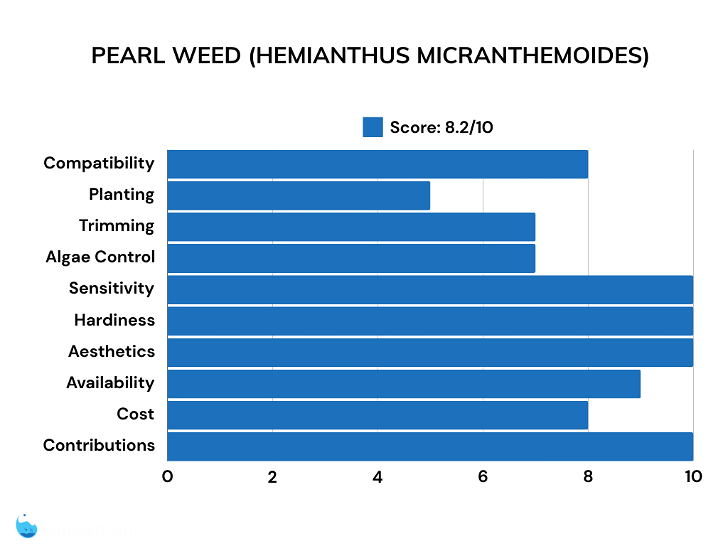
Pros:
- Fast growing, easy carpeting plant
- Eats lots of nitrate
- Can grow in soil, sand or gravel
- Provides great hiding spots for shrimp
Cons:
- Can be a pain to plant
- Requires frequent trimming
Verdict – Pearl weed is the easiest carpeting plant in the hobby, the perfect thing for shrimp to crawl around in.

Last update on 2024-04-18 / Commissions Earned / Images from Amazon Product Advertising API
7. Cryptocoryne wendtii
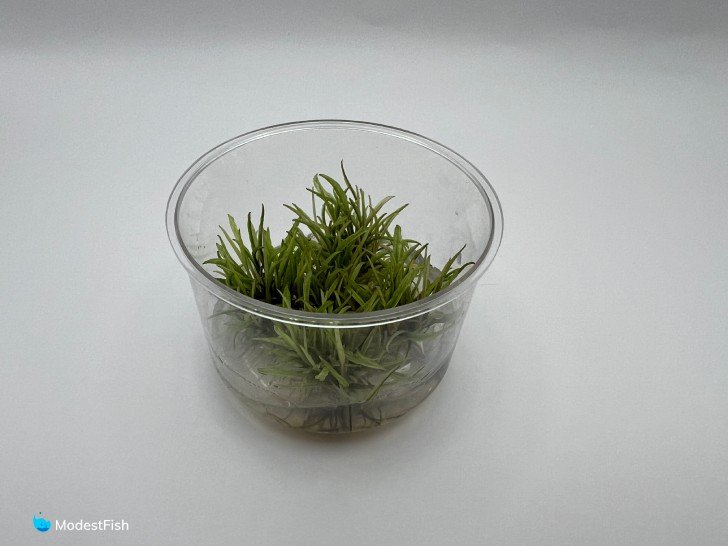
Crypt wendtii is a dwarf species that forms a messy carpet along the substrate. I love it in shrimp tanks because it gives such great cover for shrimplets.

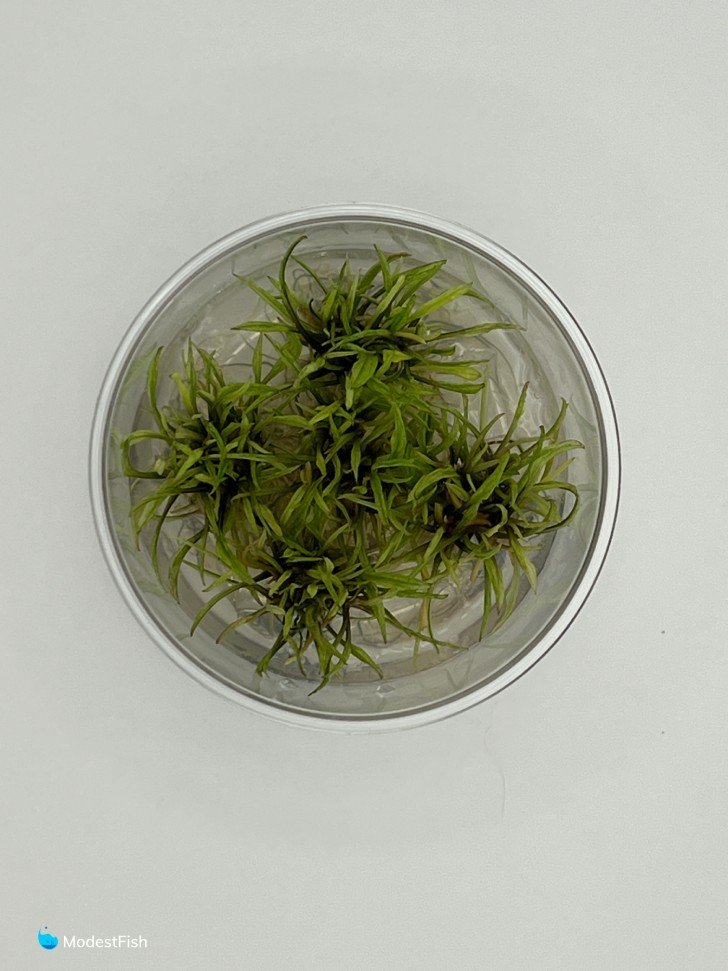
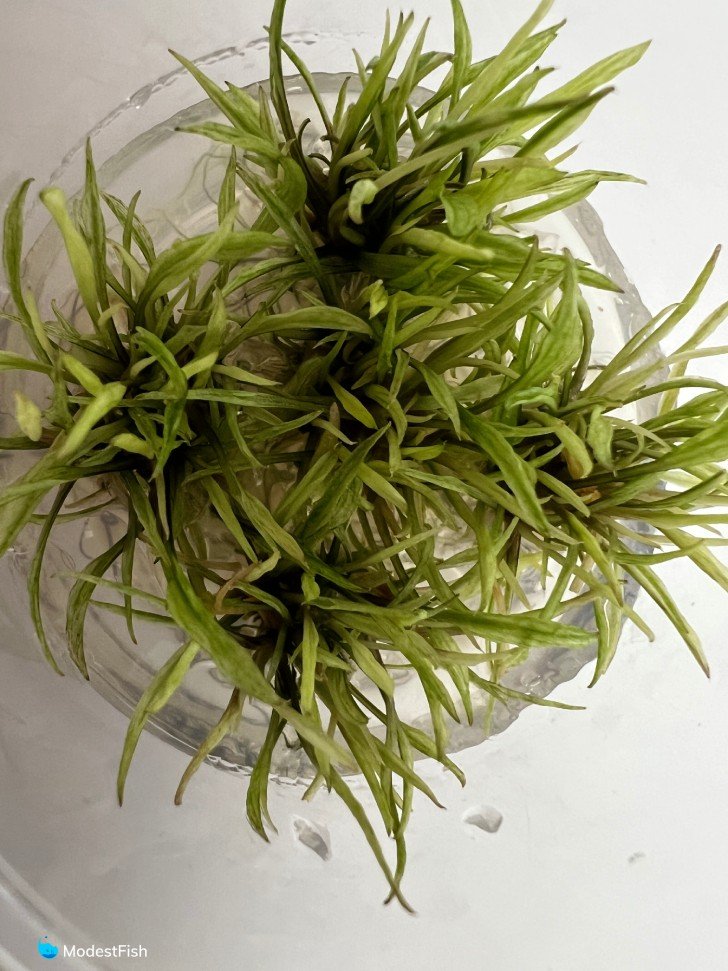
This little crypt is very sensitive. I’ve found that it will melt back when it’s first added to a tank, moved and replanted or if the water parameters change drastically.
I recommend you have a good amount of patience with crypt wendtii. Give it some time to bounce back in your shrimp tank. And over time, it’ll put out runners over time and colonize more of the tank.
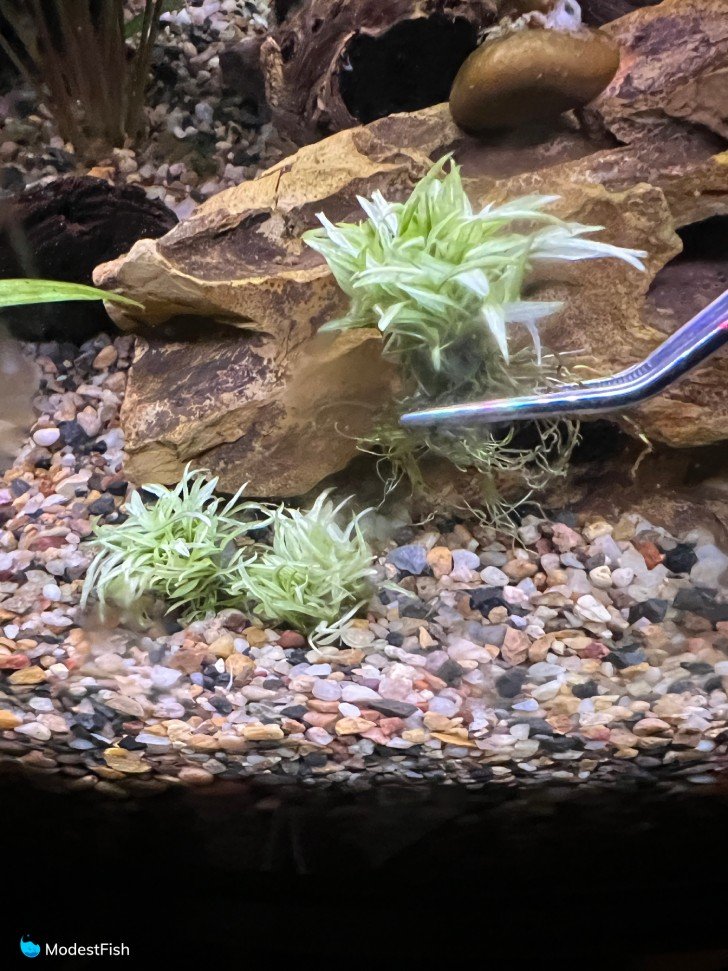
I’ve found it does best in a nutrient rich substrate. I’ve not had any luck getting it to grow in plain gravel.
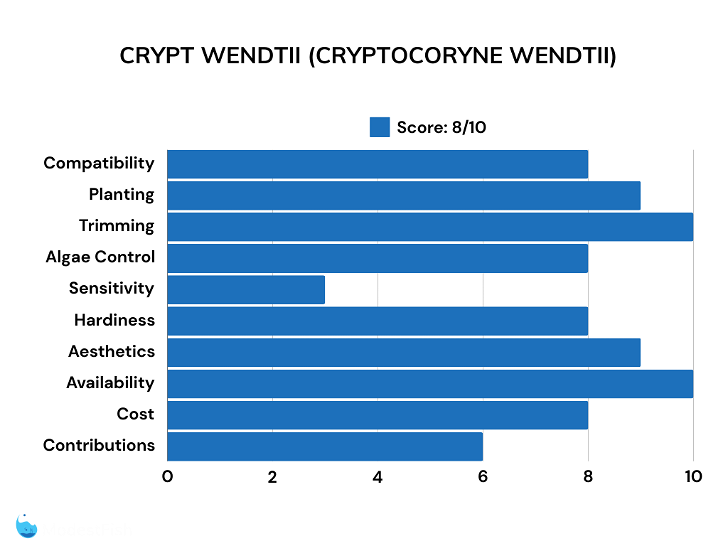
Pros:
- Small species great for foregrounds
- Easy carpeting plant
- Spreads through runners across the tank
- Great cover for shrimp and shrimplets
Cons:
- Very sensitive to changes in the water
Verdict – This tiny crypt makes an excellent foreground plant that shrimp will love to hide in.
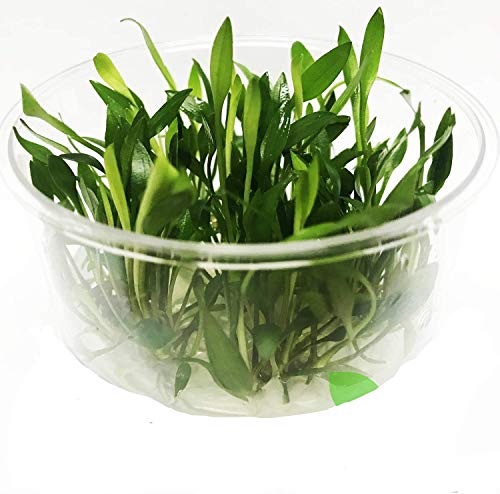
Last update on 2024-04-18 / Commissions Earned / Images from Amazon Product Advertising API
8. Java Fern (Leptochilus pteropus)
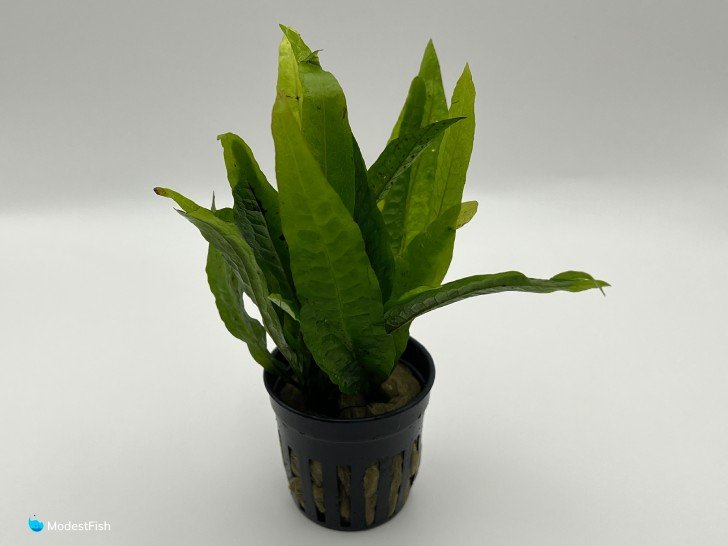
Java fern tends to be my go to in a lot of tanks. It’s easy to care for and shrimp love to graze on the leaves and roots. It’s an epiphyte plant, which means you must attach the rhizome to a surface instead of in the substrate. Planting in the substrate will cause it to rot.
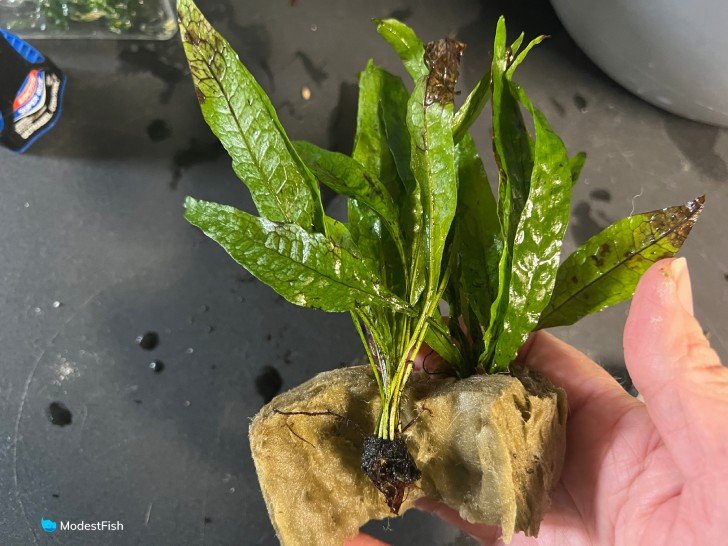
Typically, I glue it to driftwood or a rock to hold it in place. As it establishes itself in your tank it’ll anchor itself.
I’ve always thought this plant is really pretty, with rough, bright green leaves. Java ferns grow slowly, but surely, and don’t tend to need much intervention or maintenance. Java ferns grow slowly, but steadily. It doesn’t need frequent trimming and it’s fairly easy to clean algae off if necessary.
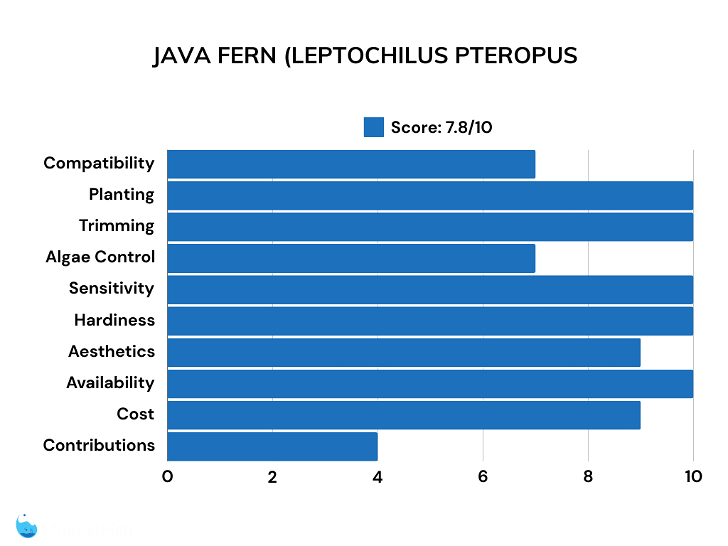
Pros:
- Tough and versatile plant
- Doesn’t require much maintenance
- Easy to plant
Cons:
- Grows slowly
Verdict – Shrimp love to graze on algae that grows on Java fern leaves and roots.

Last update on 2024-04-18 / Commissions Earned / Images from Amazon Product Advertising API
9. Water Sprite (Ceratopteris thalictroides)
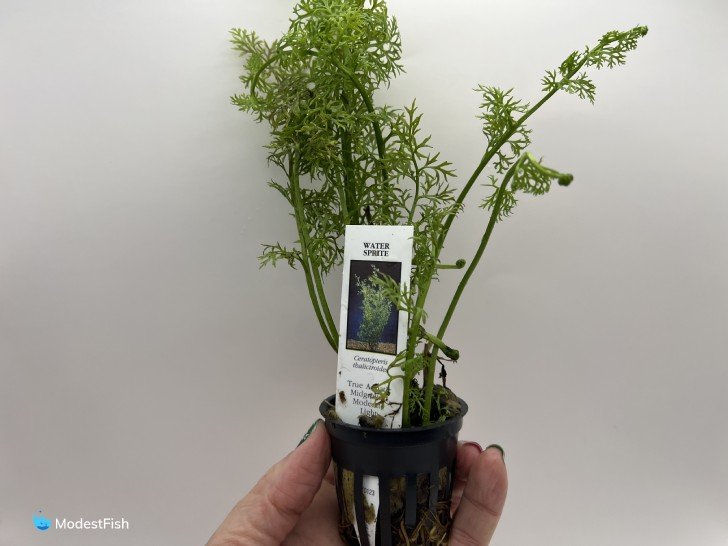
A great looking stem plant, water sprite provides a ton of surface area for shrimp to graze on and feel safe in.

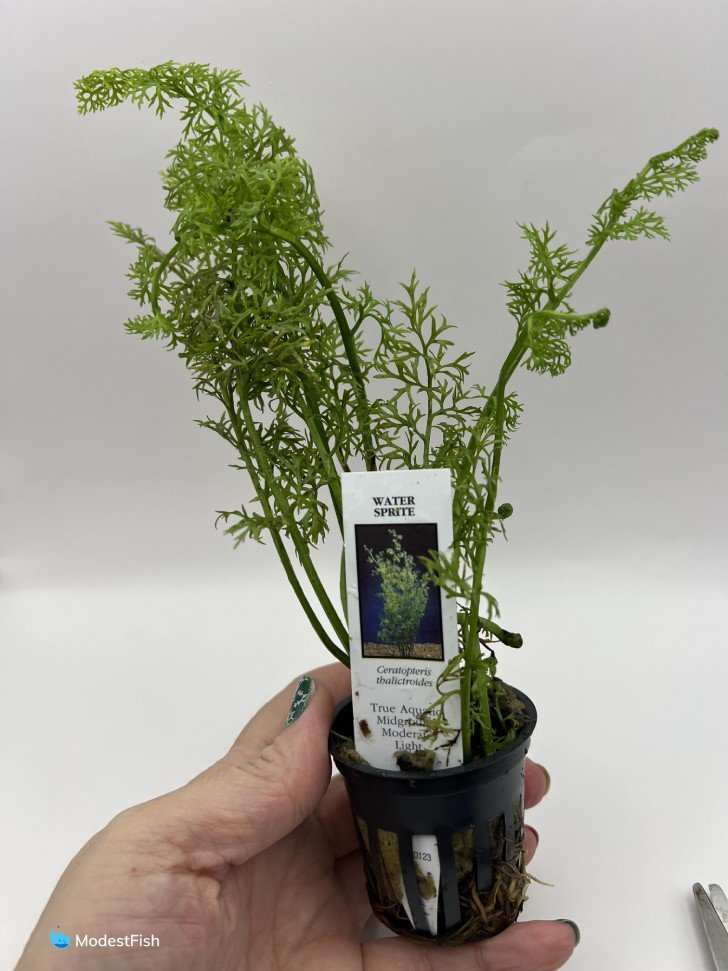
It can grow pretty quickly towards the surface, so it works best as a background plant in shrimp tanks.
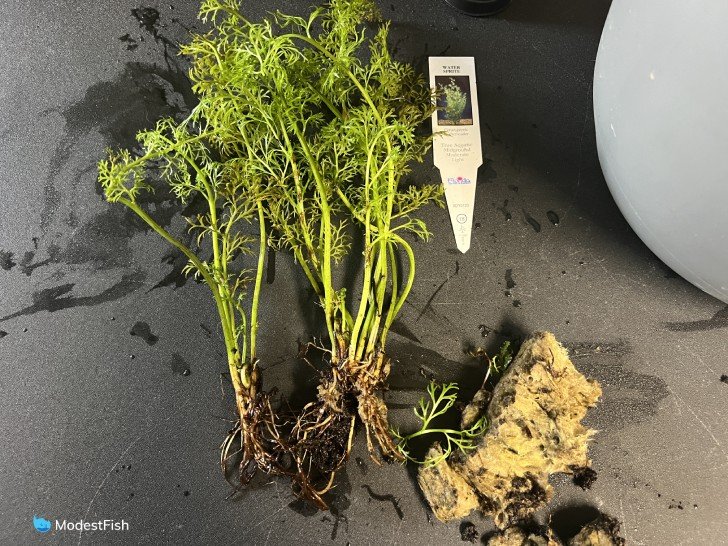
I have definitely noticed that it has a positive influence on water parameters. It eats up quite a bit of nitrate.
When planting, it can be a bit annoying to get it to stay down. I bury quite a bit of the stem, at least several inches, to keep the plant from floating off. I also sometimes place rocks around the base of the cuttings to help weigh them down.

The only thing that I don’t like about this plant is that it grows so fast, I have to frequently trim it back. But, you can chop off the tops of the plants and then bury them in the substrate to form new plants.
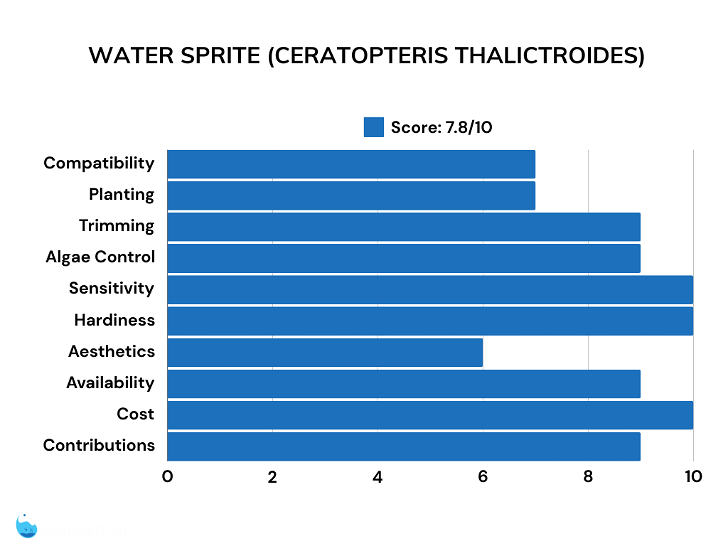
Pros:
- Fast growing plant that eats up nitrate
- Easy to propagate from cuttings
- Provides lots of places for shrimp to graze and hide
Cons:
- A bit of a pain to plant
- Requires frequent trimming
Verdict – Grows quickly, eating up nitrates, and providing lots of surface area for shrimp to graze on.

Last update on 2024-04-18 / Commissions Earned / Images from Amazon Product Advertising API
10. Water Wisteria (Hygrophila difformis)
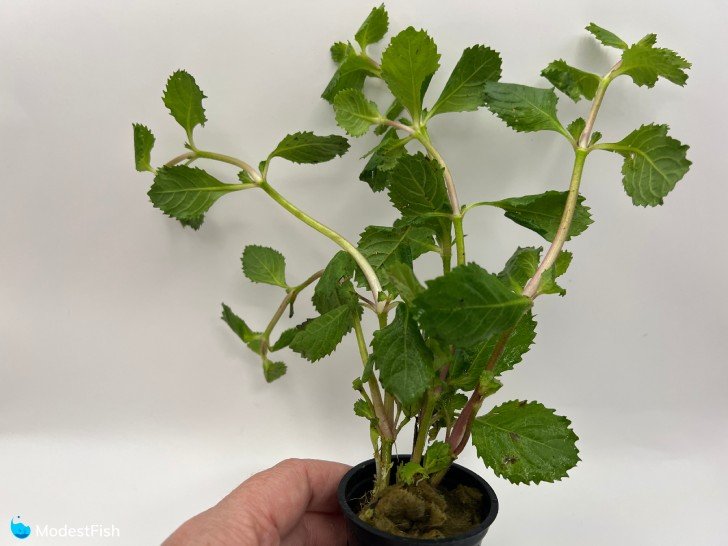
Water wisteria has grown like a weed in every tank I’ve ever used it in. It has awesome, bright green palmate leaves when grown underwater.
The best thing about water wisteria in shrimp tanks is how well of a job it does at removing nitrates. It’s one of the best plants for this.
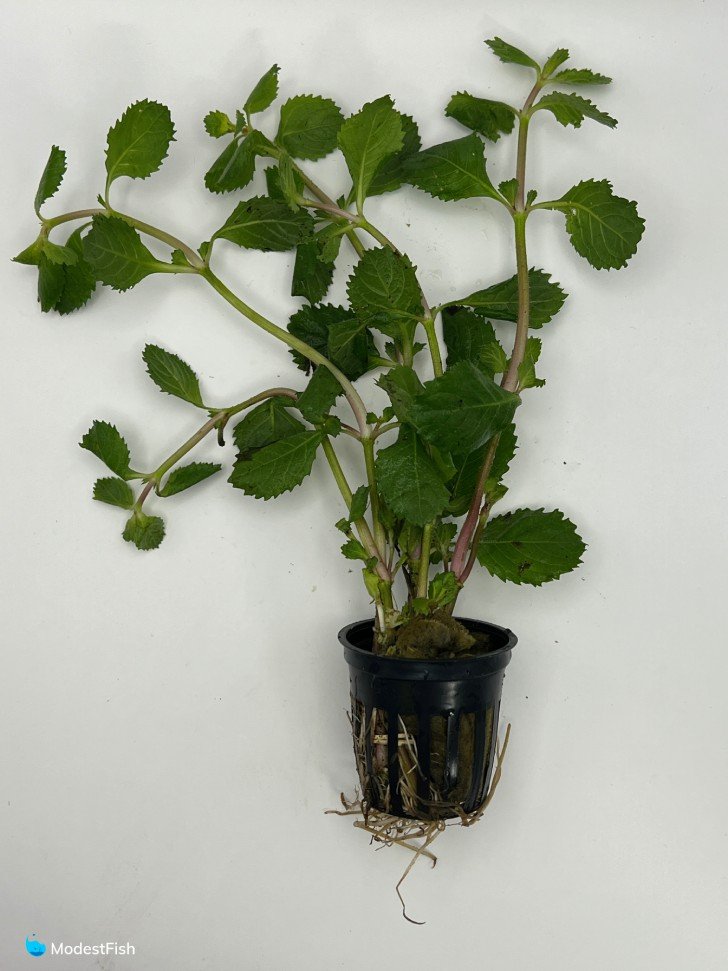
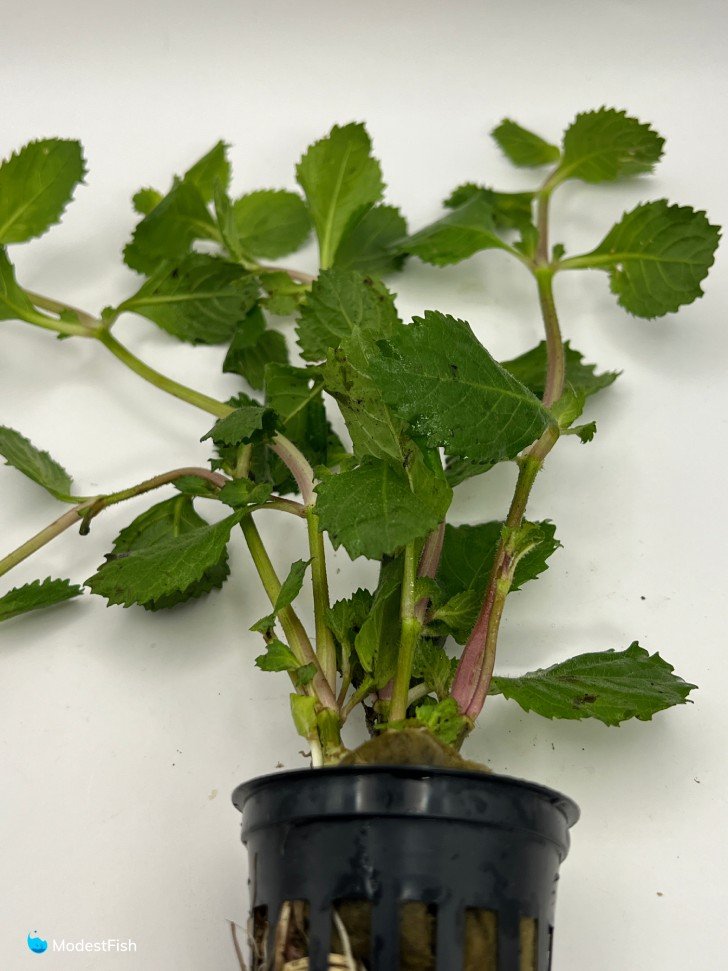
But, this does mean it requires frequent trimming. I recommend actually pulling up the plant, cutting off the tops and replanting the cuttings.
The bottom portion of the plant often loses its leaves and just looks raggedy. So this plant helps your water parameters, but it does require some labor.
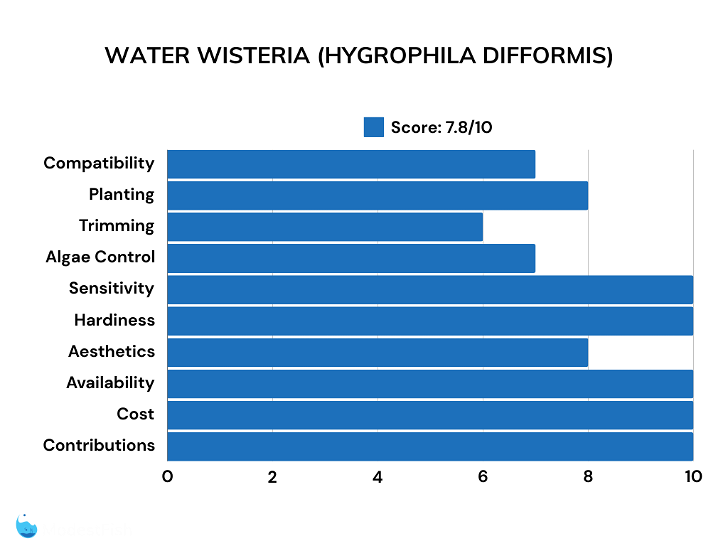
Pros:
- Fast growing
- Eats up a lot of nitrate
- Grows to the water’s surface
Cons:
- Needs frequent trimming and replanting
Verdict – Similar to water sprite, but a little less delicate; it also helps eat up nitrates, making for a healthier environment for your shrimp.

Last update on 2024-04-18 / Commissions Earned / Images from Amazon Product Advertising API
11. Anubias barteri
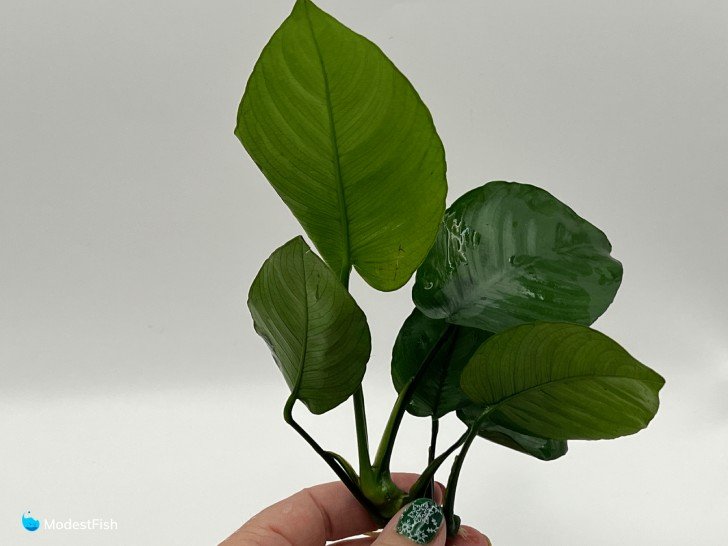
This is probably my favorite species of anubias. I just love the shape and texture of the broad leaves. And so do my shrimp, as I often see them grazing on them.
Shrimp don’t like super bright tanks, so species like anubias work well as they don’t require much light. It’s a tough plant, doesn’t require much upkeep and will adapt to a wide range of water parameters.
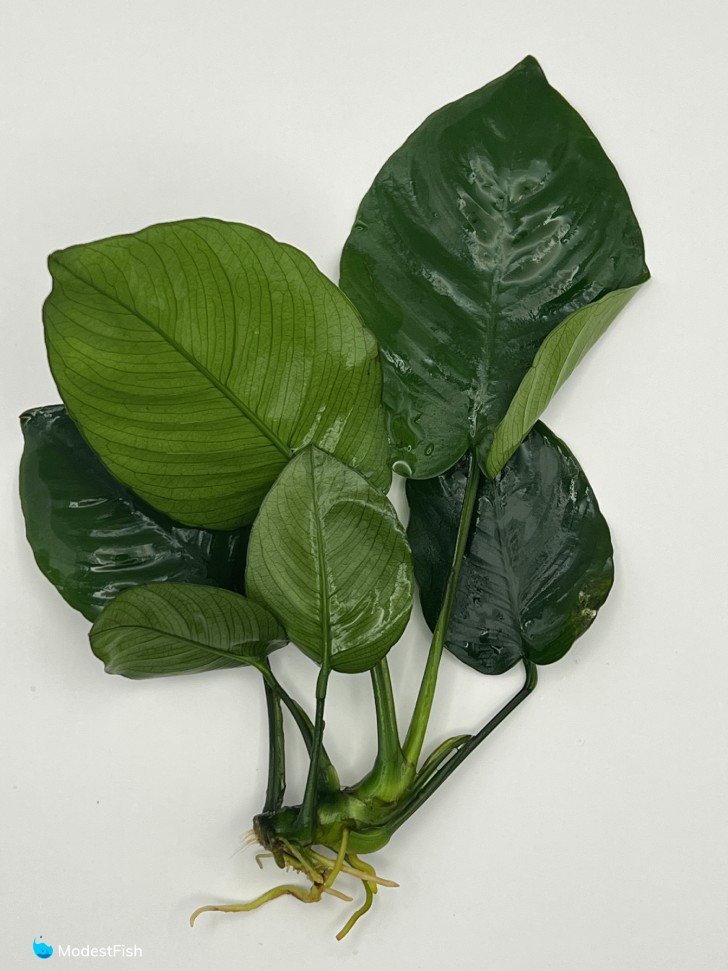
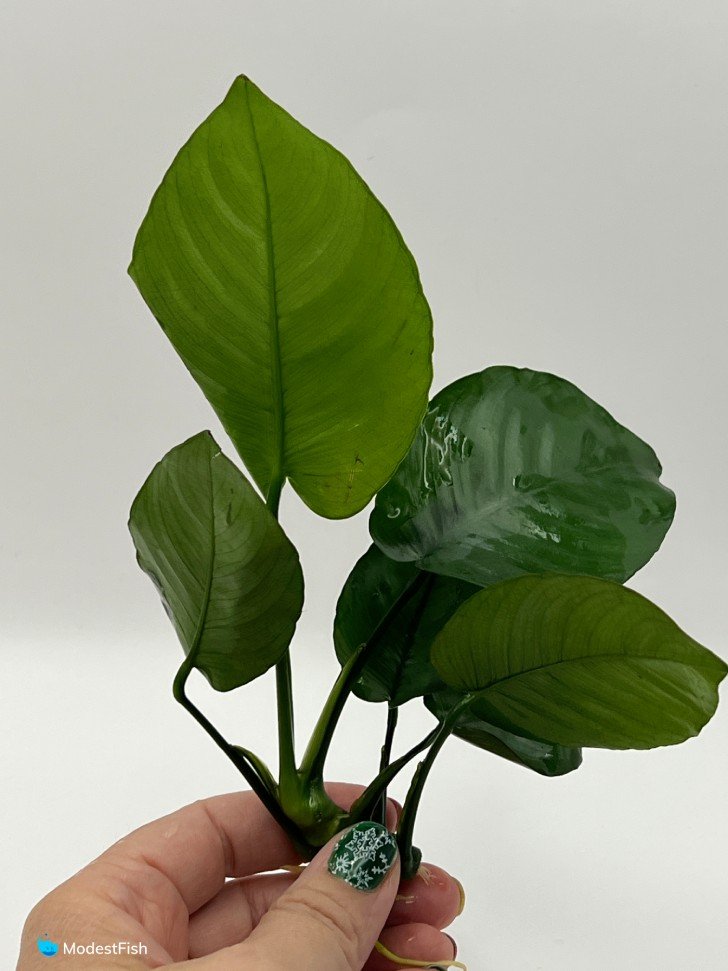
It’s an epiphyte, a plant that lives attached to hard surfaces, like logs or rocks, instead of rooted in the substrate. Planting is easy. I just glue the rhizome to rocks or driftwood in the aquarium and leave it to grow.
Just make sure you’re using a pure cyanoacrylate glue, so it will even set underwater.
Be patient when pressing the plant against the surface of something with the glue. The glue will take up to two minutes to set up properly and keep the plant there.
A lot of the time, I glue my anubias plants to small rocks, something just big enough to weigh it down, so I can pick it up and move it in the tank any time I want.
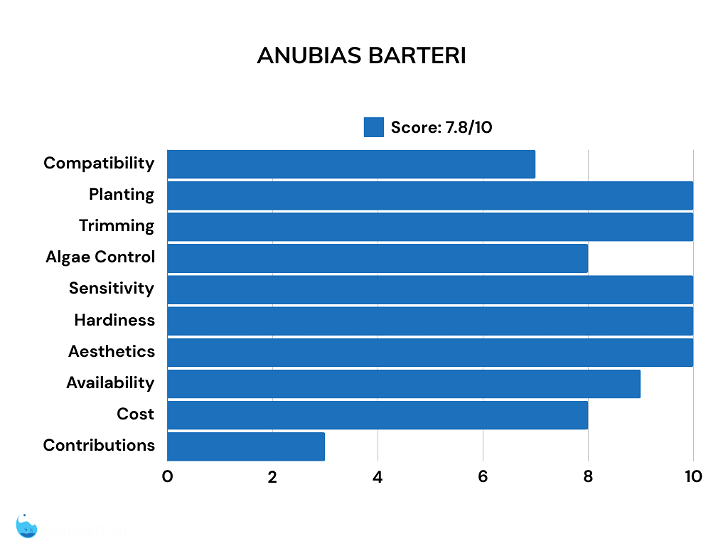
Pros:
- Beautiful leaf shape and texture shrimp loves to hang out on
- Hardy and undemanding
- Easy planting
- Doesn’t need much trimming
Cons:
- Slow growing
- Doesn’t remove a large amount of nitrates
Verdict – This anubias species is easy to care for and has beautiful broad leaves that shrimp can graze along.
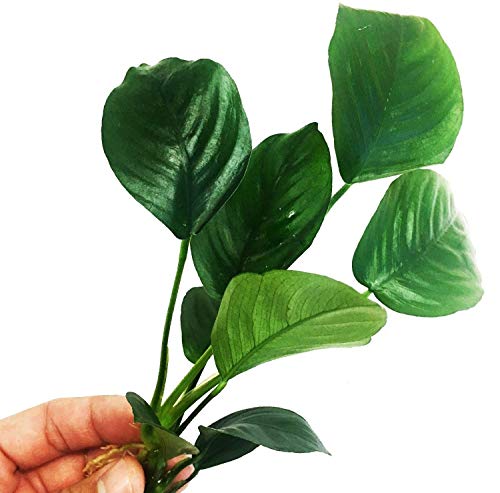
Last update on 2024-04-18 / Commissions Earned / Images from Amazon Product Advertising API
12. Anubias nana
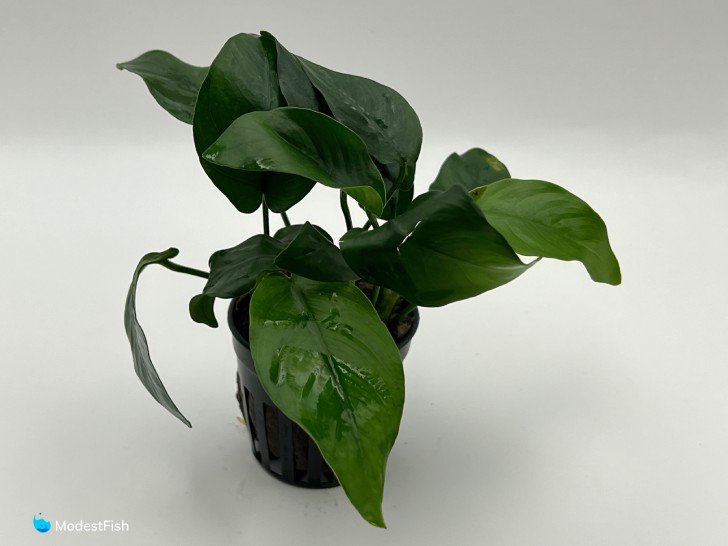
This is a good plant for smaller shrimp tanks, 20 gallons (76 liters) or less. Anubias nana likes to send out long rhizomes with tiny leaves across the tank.
I have found shrimp do enjoy the cover they can provide in the foreground of aquariums. Try to avoid having too many larger growing or faster growing species over shadowing it. I’ve lost a few to this over the years.
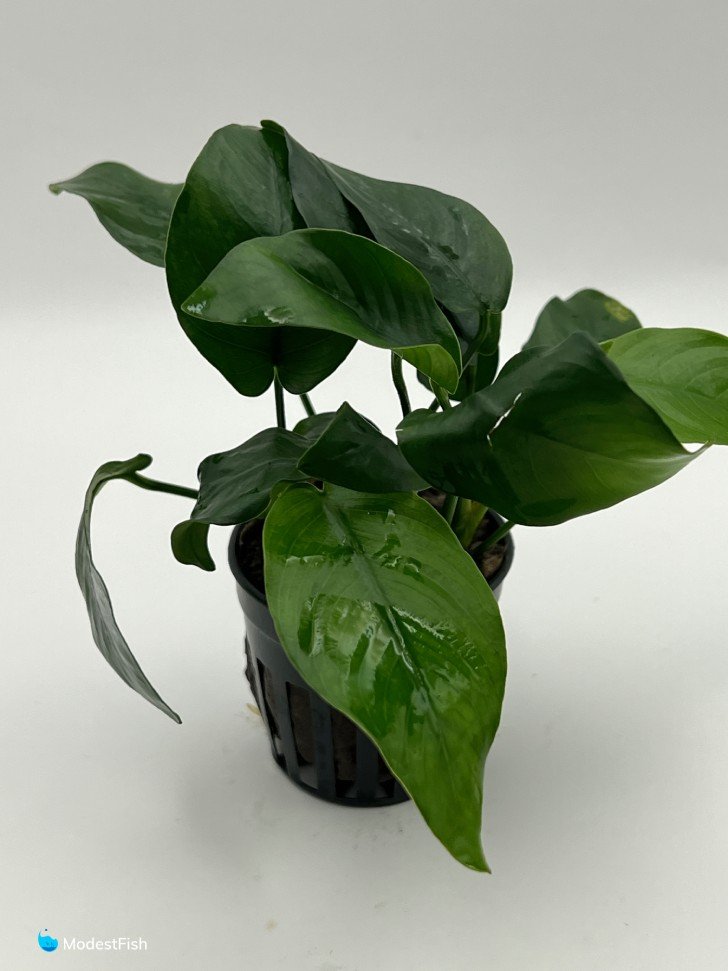
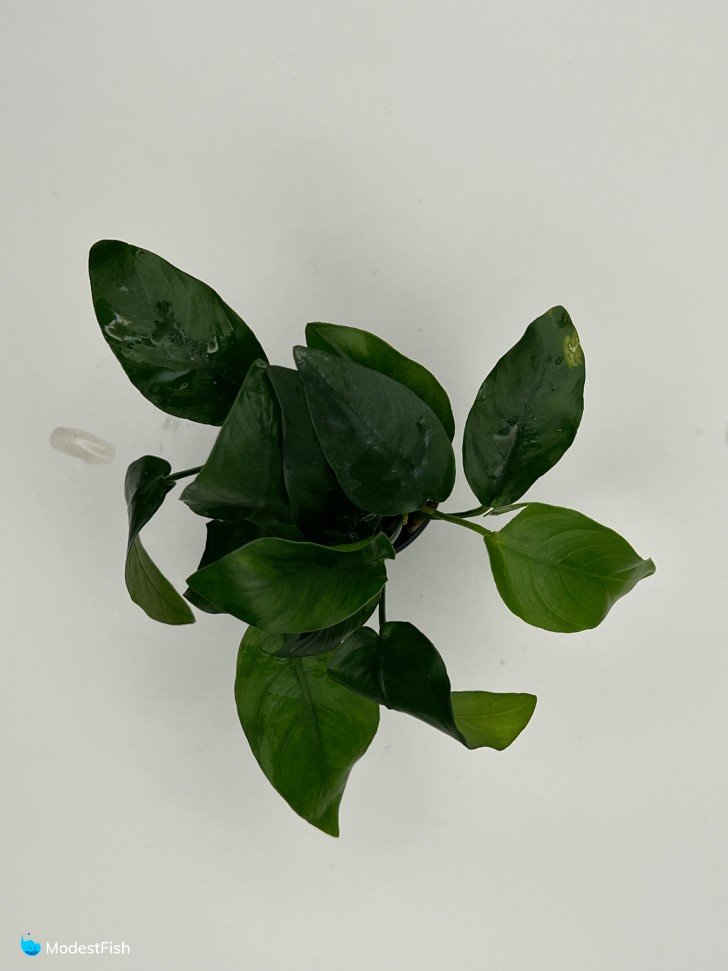
It grows slowly, and can get a bit of algae on, but generally your shrimp will enjoy grazing on this.
And if you want to clean it off, I’ve found spot treating with seachem excel to work.
With anubias nana you can mostly just plant and leave it to its own devices.
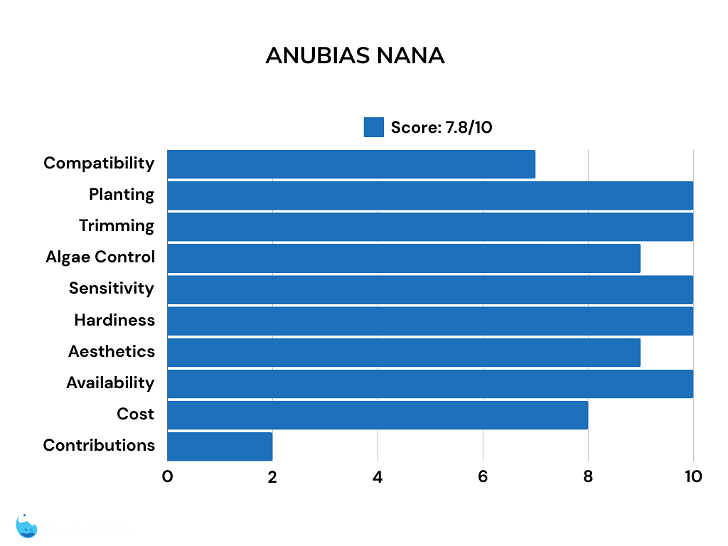
Pros:
- Perfect dwarf plant for small tanks
- Shrimp like to eat the algae on the leaves
- Easy to plant and needs almost no trimming
- Thrives on neglect
- Great no maintenance foreground plant
Cons:
- Easily overshadowed by larger plants
- Grows slowly
- Doesn’t eat up much nitrate
Verdict – A dwarf species that can provide good cover for shrimp in the foreground of a tank.

Last update on 2024-04-19 / Commissions Earned / Images from Amazon Product Advertising API
13. African Water Fern (Bolbitis heudelotii)
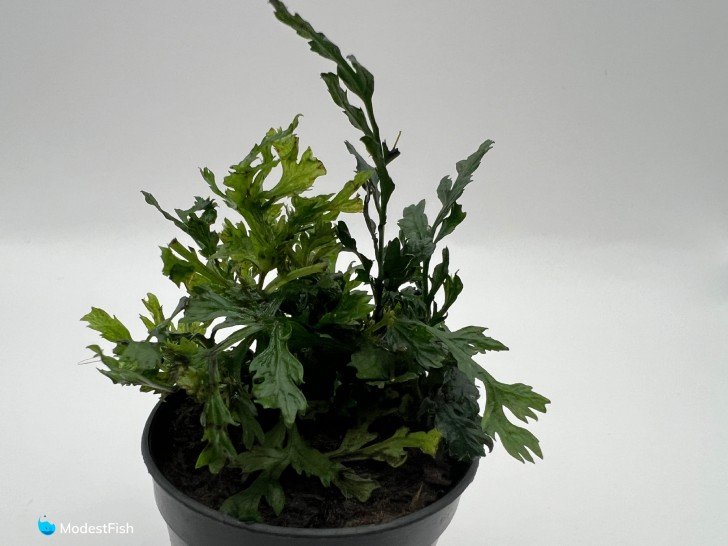
I love, love, love this plant in shrimp tanks! It makes a great background plant for tall tanks. I have it growing in the back corner of three of my tanks.
It can take some time for it to establish, sometimes I’ve noticed it doesn’t grow at all for a couple months. After which, it’ll grow tall and fill a lot of space.
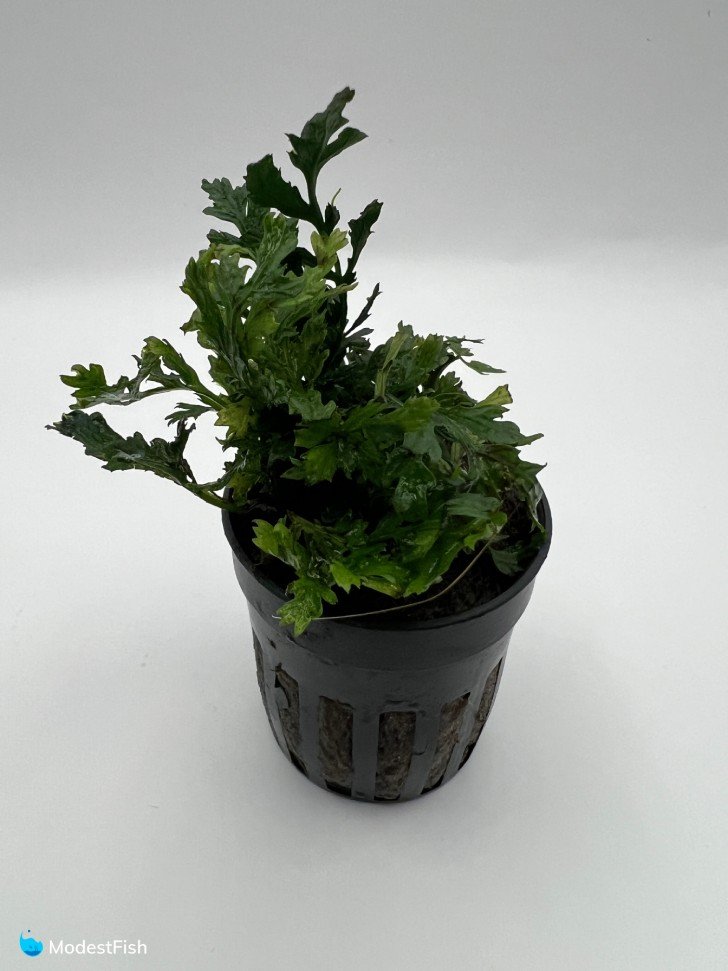
The messy tangle of terrestrial fern fronds creates a wonderful jungle environment for shrimp to explore and feel safe in.
At first, when this plant is small, it doesn’t do that much for water parameters because of its slow growth rate. But, I’ve noticed it having more of an impact once the fern got really big.
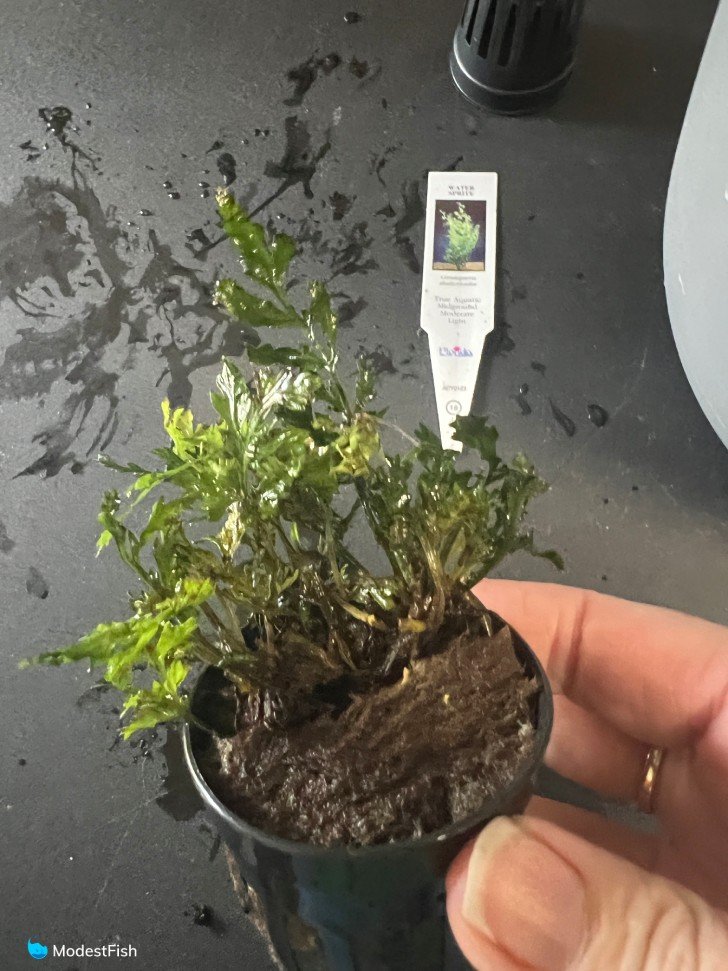
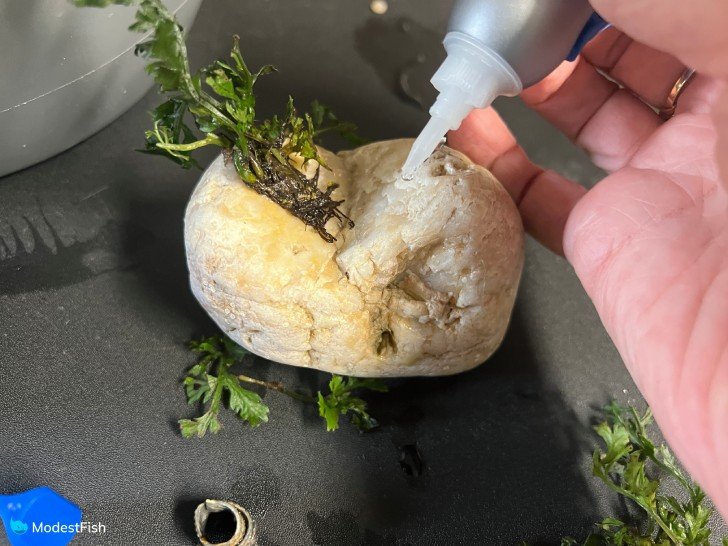
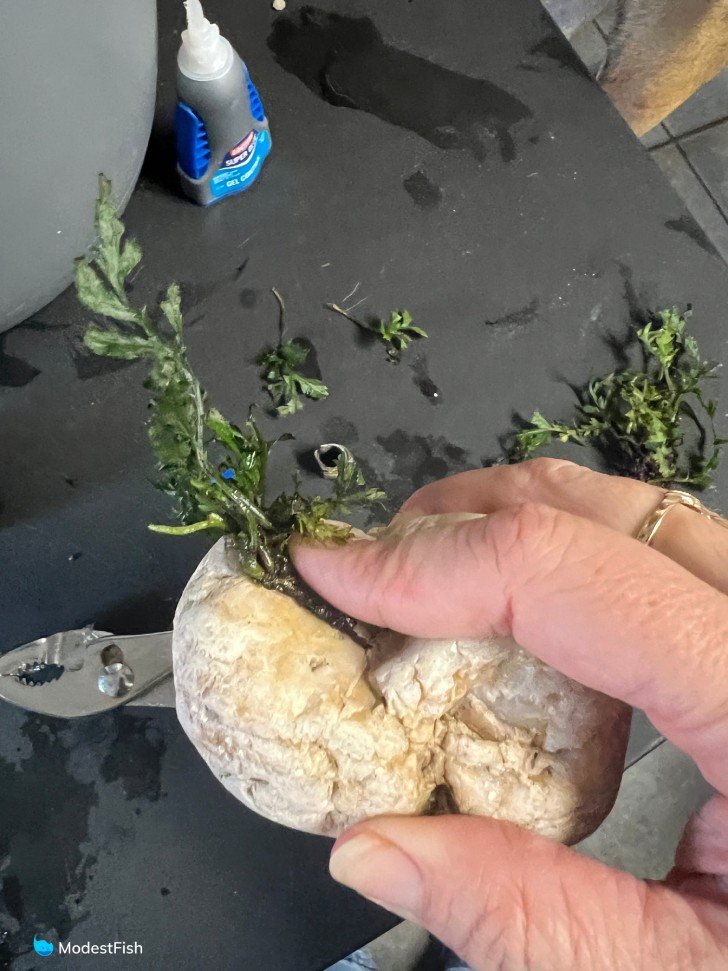
This plant doesn’t require frequent trimming, but it can get quite large, if left to its own devices. Two of mine are starting to get massive. But, it’s simple to cut this plant back and any cuttings you have can be rooted to make new plants.
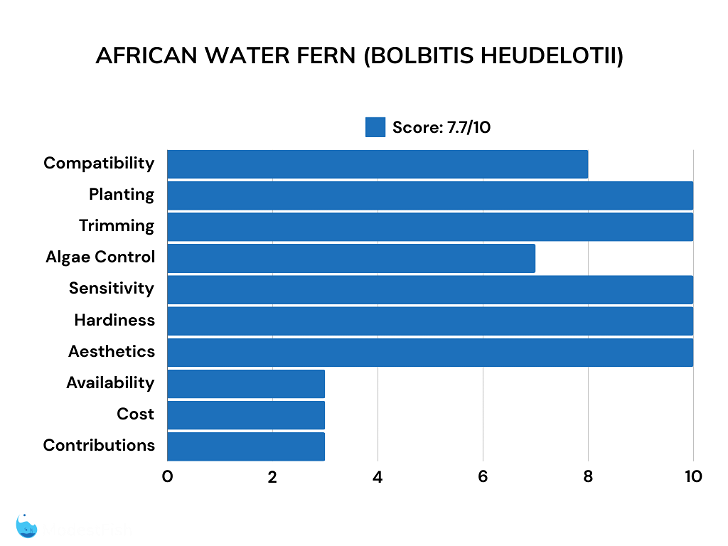
Pros:
- Easy to plant
- Doesn’t require frequent trimming
- Easy, large background plant
- Creates cover for shrimp
Cons:
- Slow to get established
- Slow growing, especially at first
Verdict – This plant is slow to grow, but provides an excellent feeding ground for shrimp in large tanks.

Last update on 2024-04-19 / Commissions Earned / Images from Amazon Product Advertising API
14. Cryptocoryne lutea (Cryptocoryne lutea)
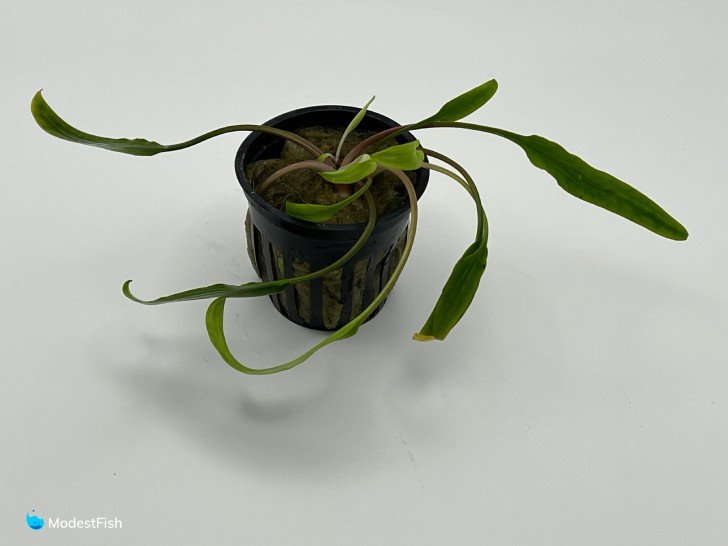
Cryptocoryne lutea is one of my favorite foreground plants. It’s a heavy root-feeder that needs to draw nutrients from the substrate. Either an aqua soil or clay-based substrate that’ll absorb liquid fertilizers will provide the best results.
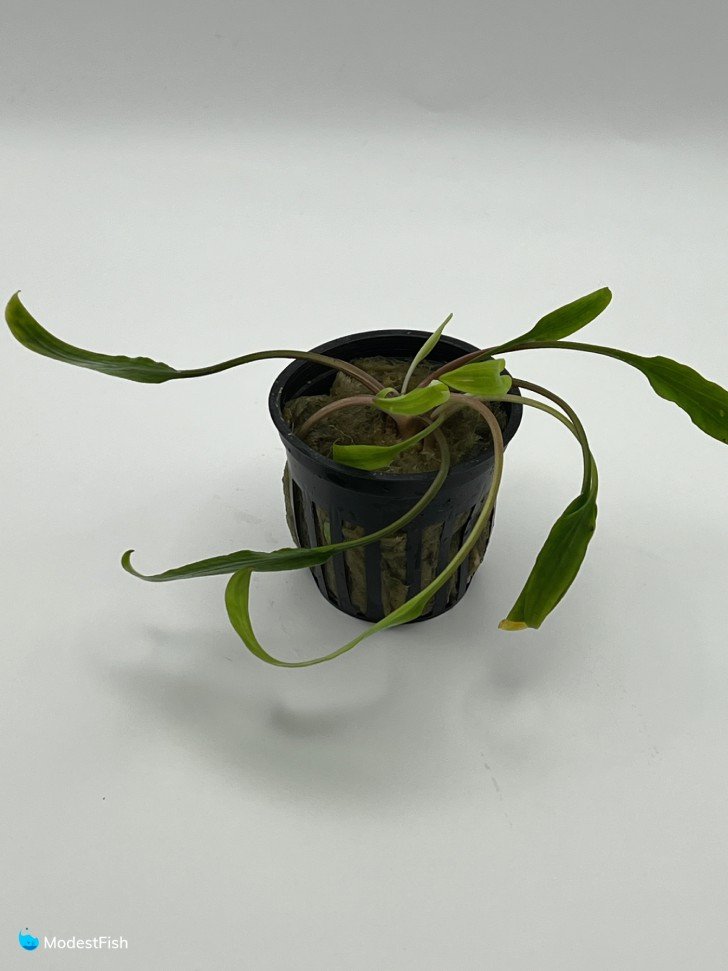
I like this crypt species is kind of in the middle as far as size goes. It grows to around 6 inches (15 centimeters) tall. And its broad leaves provide loads of surface for shrimp to graze on.
The big downside is it can be very sensitive. Crypts are famous for “melting” if there are major changes in water parameters.
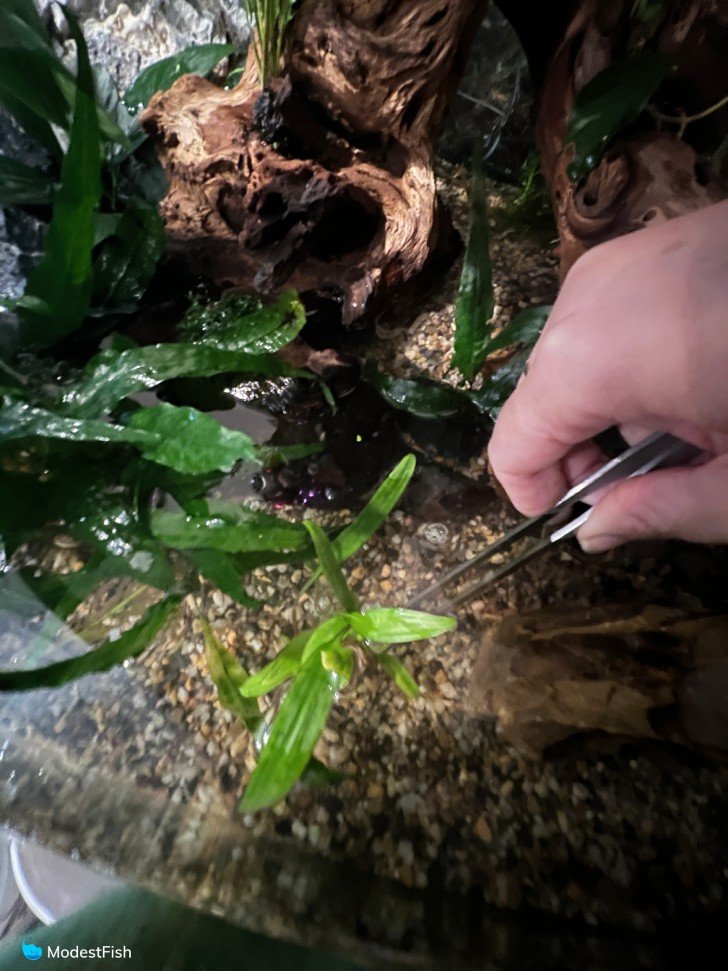

All of the leaves will suddenly die back and it will seem like the plant is a lost cause. Usually, the crypt bounces back and starts to put out new leaves after a week or so, but it can be distressing when all of your lovely plants rapidly die back to nothing but roots.
Be warned, this can often happen when this plant is first added to a new tank. Give it a week to recover, you should see new leaves start to sprout.
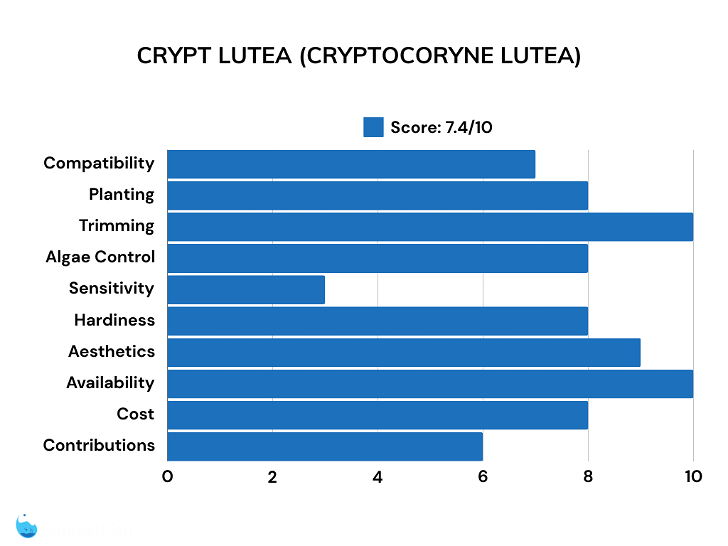
Pros:
- Excellent, low light foreground plant
- Spreads along the substrate, filling open spaces
- Provides excellent cover for shrimp
- Good for medium to large tanks
Cons:
- Needs a nutrient rich substrate
- Very sensitive to changes in water parameters
Verdict – This large crypt species makes an excellent centerpiece plant with broad leaves shrimp can graze along.
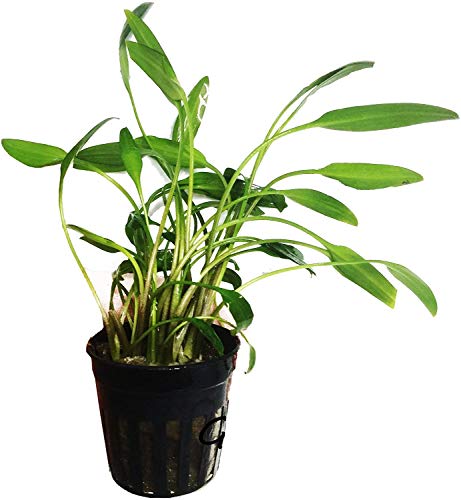
Last update on 2024-04-18 / Commissions Earned / Images from Amazon Product Advertising API
15. Marimo Moss Balls (Aegagropila linnaei)
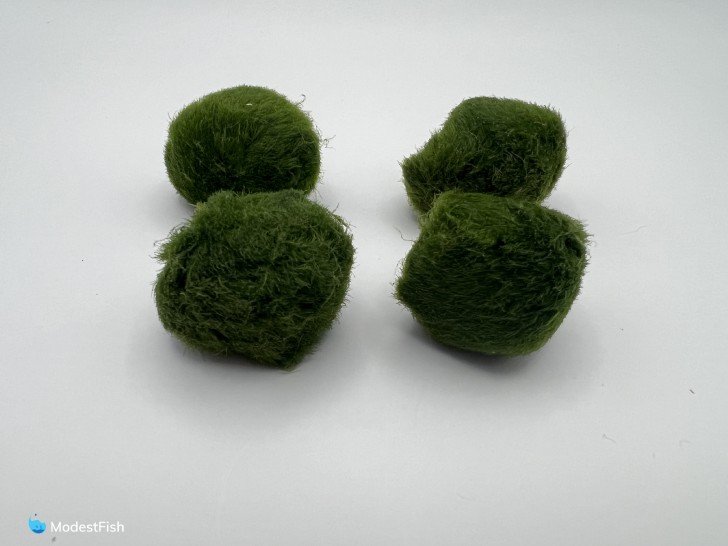
I think these little guys are a great addition to a shrimp tank. I keep moss balls in all my shrimp tanks and love watching them graze and play on them.
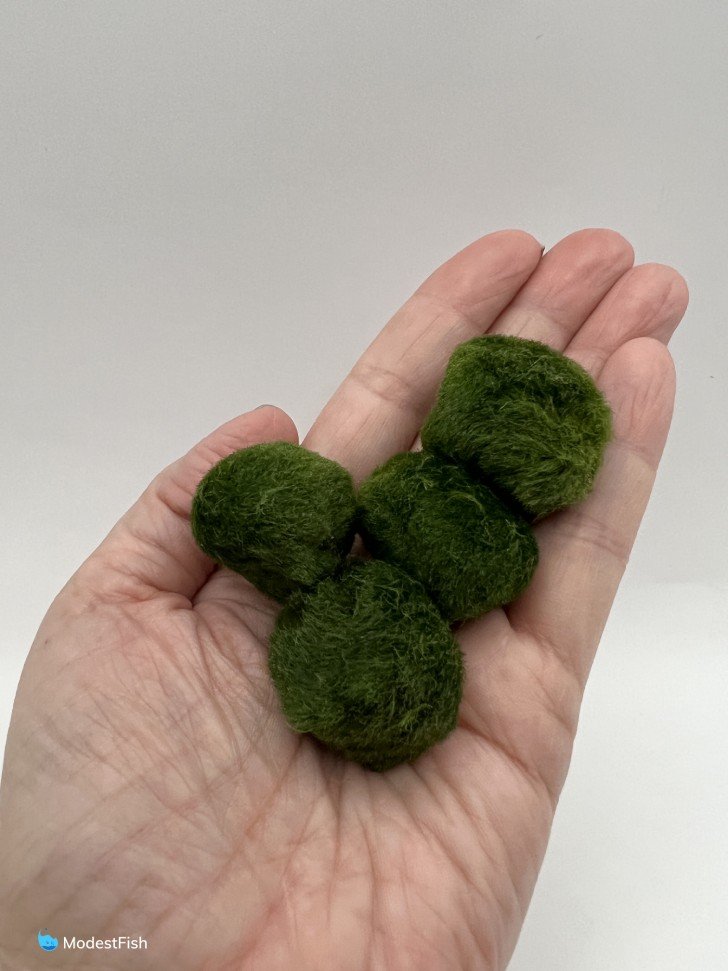
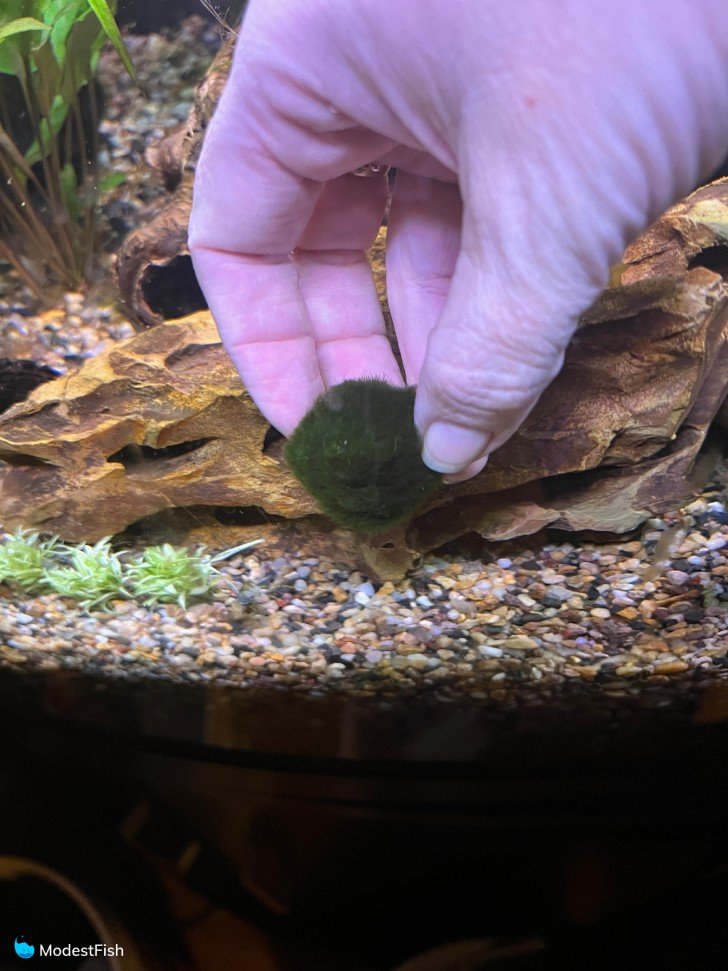
Their maintenance is easy, just squeeze them out occasionally to get rid of any trapped debris. Also turning them occasionally so all sides can get some light is also good.
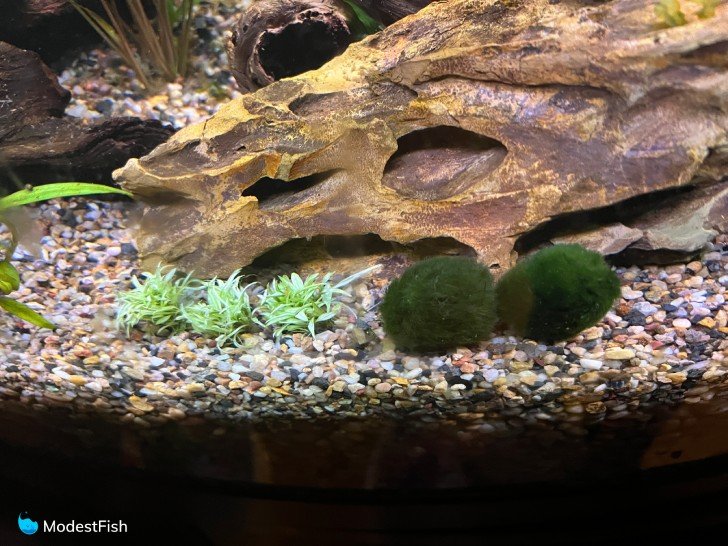
The only reason they score so low is they grow so slowly and barely eat up any nitrates. But, they are fun and it’s super cute to watch shrimp play on them.
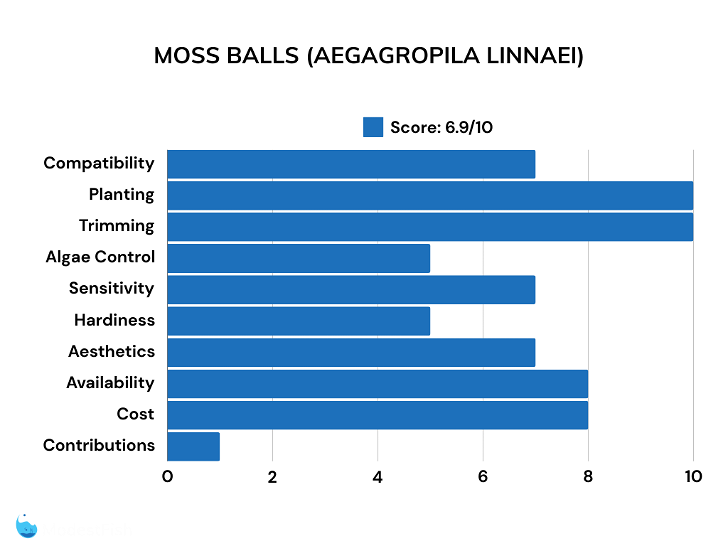
Pros:
- Interesting little plant
- Shrimp love them
- Easy to care for
Cons:
- Grows very slowly
Verdict – These little green oddballs require almost no care and shrimp love to graze on them.

Last update on 2024-04-18 / Commissions Earned / Images from Amazon Product Advertising API
Which Plants To Pick?
Having plants in your shrimp tank is essential. They provide them a place to hide, feed, and breed. The safer shrimp feel in your tank, the more joy you’ll get seeing them busily explore your tank.
After planting, caring for, and ranking each plant, I have to say the java moss, guppy grass, anacharis, and anubias congensis do an excellent job of providing everything shrimp need to feel safe.
But, even if a plant scores low in this list, it’s still suitable for your shrimp tank. Marimo moss balls are last on my list, but I keep them in all my shrimp tanks, because they work well in conjunction with other faster growing plants in the list. They just don’t do much other than provide a place for shrimp to play.
My recommendation is to get a variety of different kinds of plants. Get yourself some fast growing stem plants, slower growing epiphytes like anubias, and some moss. All together, they’ll help maintain stable water parameters and provide a safe natural environment for your shrimp to thrive and live a long healthy life.
